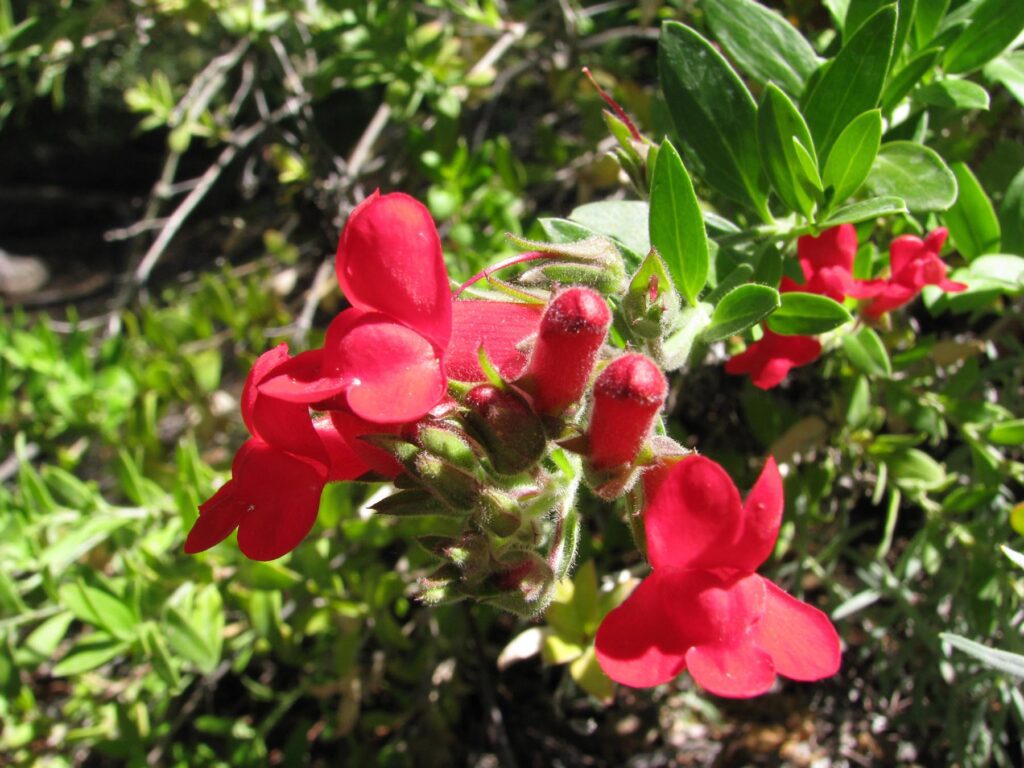All of the plants in the Sacred Hoop Garden are native to California.
Following is a list of the plants in and around the garden. A plan is included so each plant can be easily located as you walk through the garden.. The list includes some of the documented uses by native people for each plant, as food, medicine, basket weaving, tool making, home building, and others. Enjoy and discover as you walk around the garden.
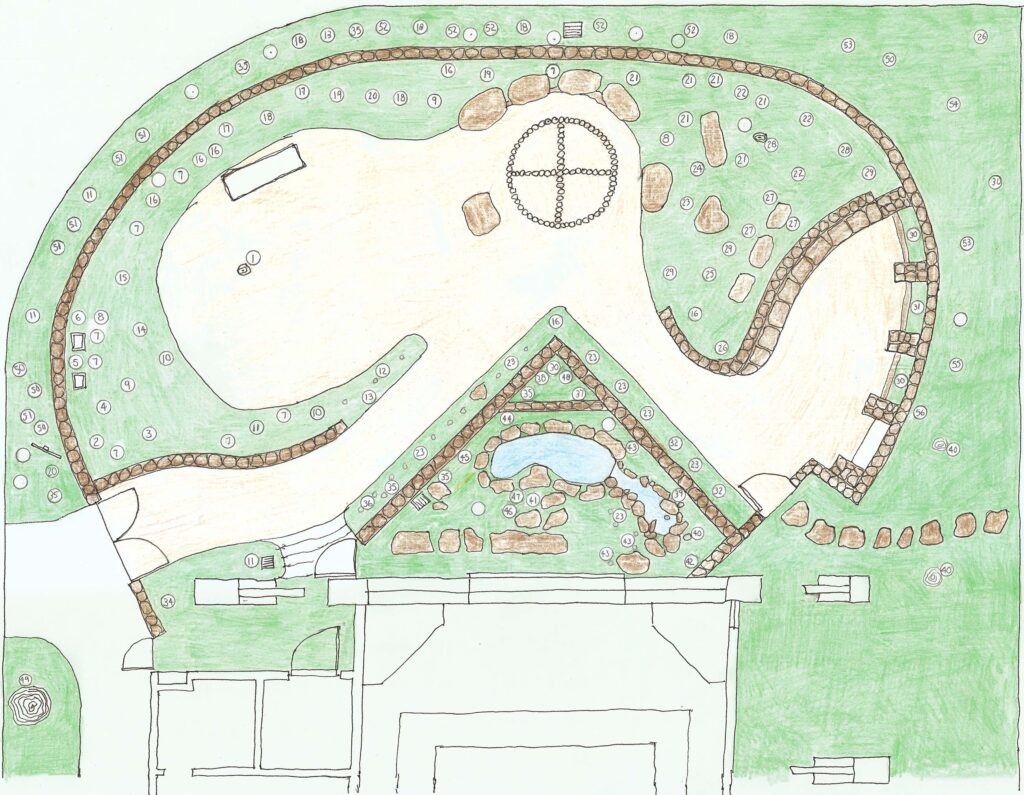
Plant List
1
Coast Live Oak, Quercus agrifolia. Evergreen oak 25’ to 82’ tall, 15’ to 35’ wide, full sun to part shade, low moisture. Pendulous catkins make acorns. Acorns ground with a pestle in a mortar sifted to a fine flour, and rinsed to leach the tannins. Flour was baked into bread or eaten as a soup or thick cereal. It was stored and eaten year round even though harvest lasted only two or three weeks.

2
Howard McMinn Manzanita, Archtostophylos densiflora. “Everyman’s manzanita” grows in a wide variety of conditions, 8’ tall, 10’ wide, full sun to partial shade, low to moderate moisture. Long narrow glossy leaves, Clusters of light pink flowers. Medicinal tea for poison oak rash, disinfectant, urinary tract infections. Chewing leaves can make a poultice for stomach cramps and aches. Leaves can treat diarrhea and colds. Berries are food, sweetener, cider. Red branches used decoratively and are good campfire wood.
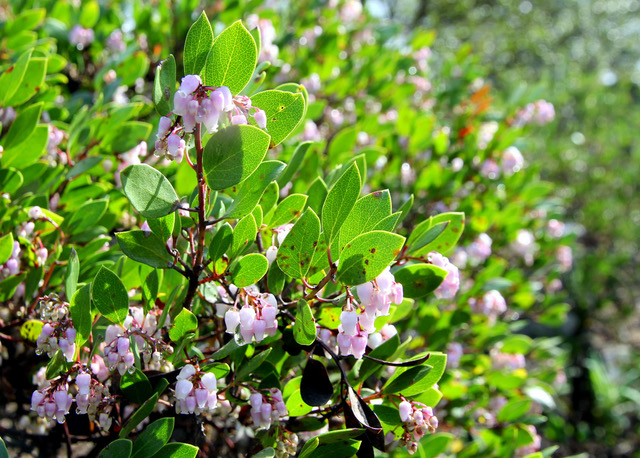
3
Hummingbird Sage, Salvia spathacea. Evergreen perennial, 1’ to 3’ tall, 3’ wide. Full sun to full shade especially in dry shade under oaks, very low moisture. Aromatic leaves. Rhizome roots. Bright green leaves covered with hairs, soft to touch. Dark red flowers in clusters. Supports hummingbirds, bees, butterflies. Used medicinally for mouth and throat conditions, cysts, fibroid tumors, and inflammation. Roots used as diuretic to stimulate kidney function.
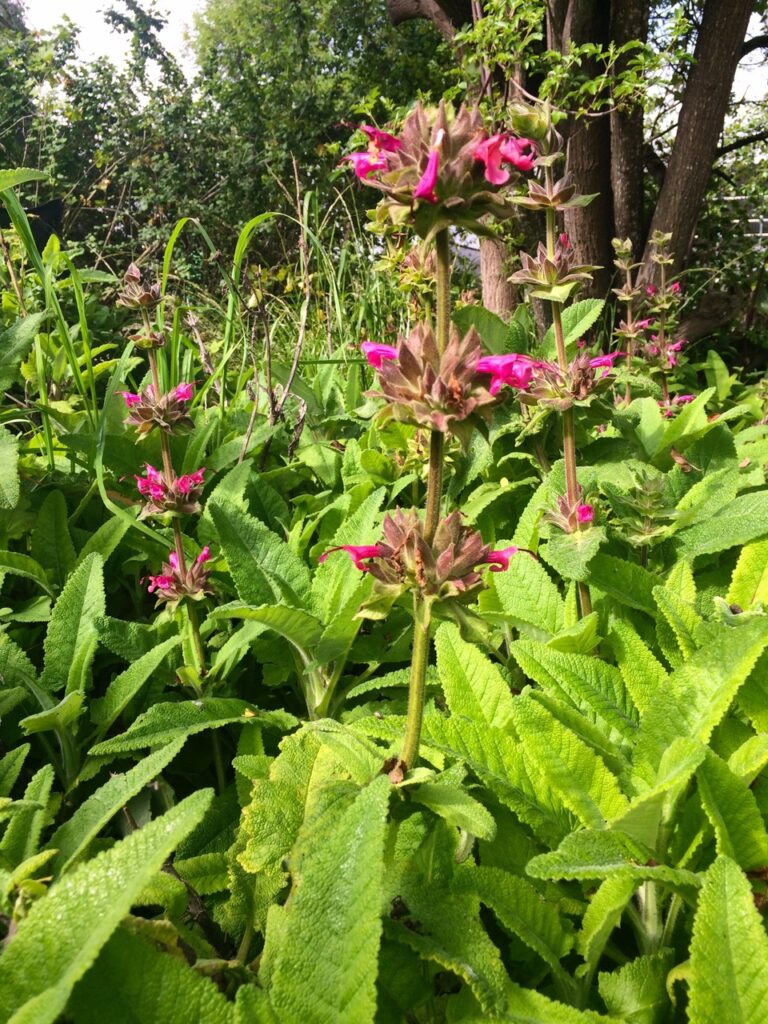
4
Manzanita, existing, low growing groundcover.
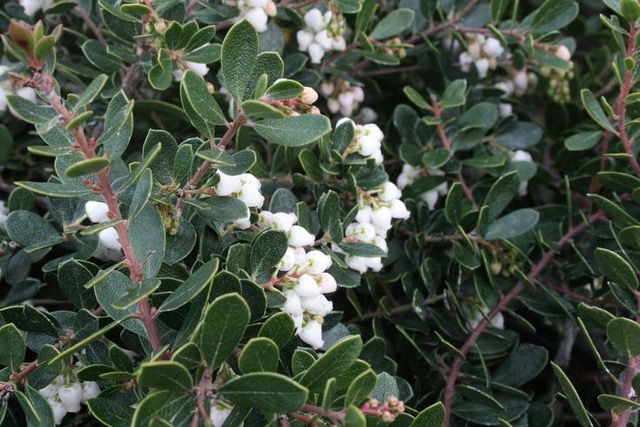
5
Bladderpod Spiderflower, Peritoma arborea. Evergreen shrub 2’ to 6’ tall, 6’ wide. Full sun, low moisture. Long pointed oval leaves in three equal leaflets. Abundant bright yellow flower clusters at end of stem branches. found in deserts and coastal bluffs, bloom in all months, ill smelling. Supports hummingbirds and butterflies. Leaves are boiled to remove bitterness and eaten.
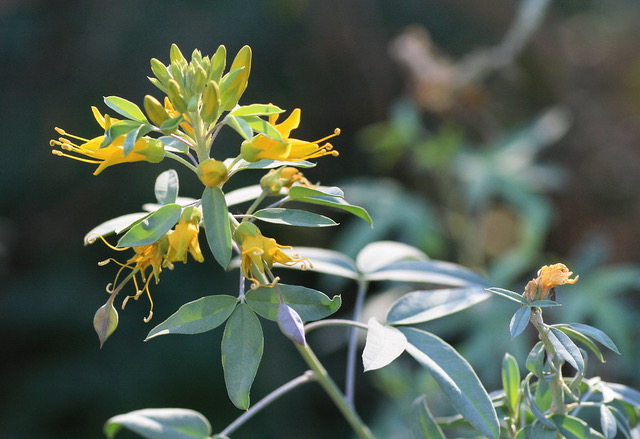
6
Twinberry, honeysuckle, Lonicera involucrate. Deciduous shrub 3’ to 8’ tall, 3’ to 4’ wide. Part shade to full sun, often Creekside. Moderate to high moisture Oval shaped leaves hairy on the side and bottom. Flowers are tubular, hairy, in pairs. Fruit is small black berries. Berries are poisonous to humans, could be used to induce vomiting, prevented dandruff and to die hair when applied to scalp. Berries were used to dye other materials like basketry. Bark used to soak sore feet, an eyewash, and for coughs. Leaves chewed and applied to sores and itches.
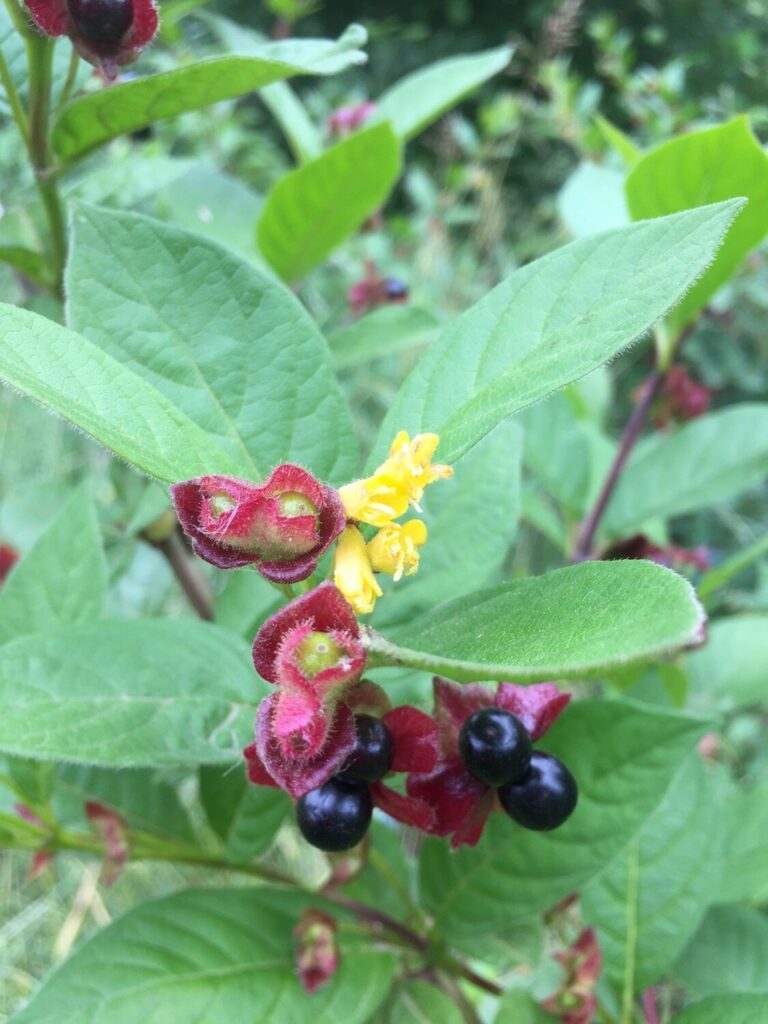
7
Coyote Mint, Monderella villosa. Perennial herb subshrub, 2’ tall and 3’ wide, full sun to part shade, very low moisture. Hairy mint scented foliage, with rounded lavender or pink flower clusters. It is edible, used to make mint tea and for stomach aches and sore throat.
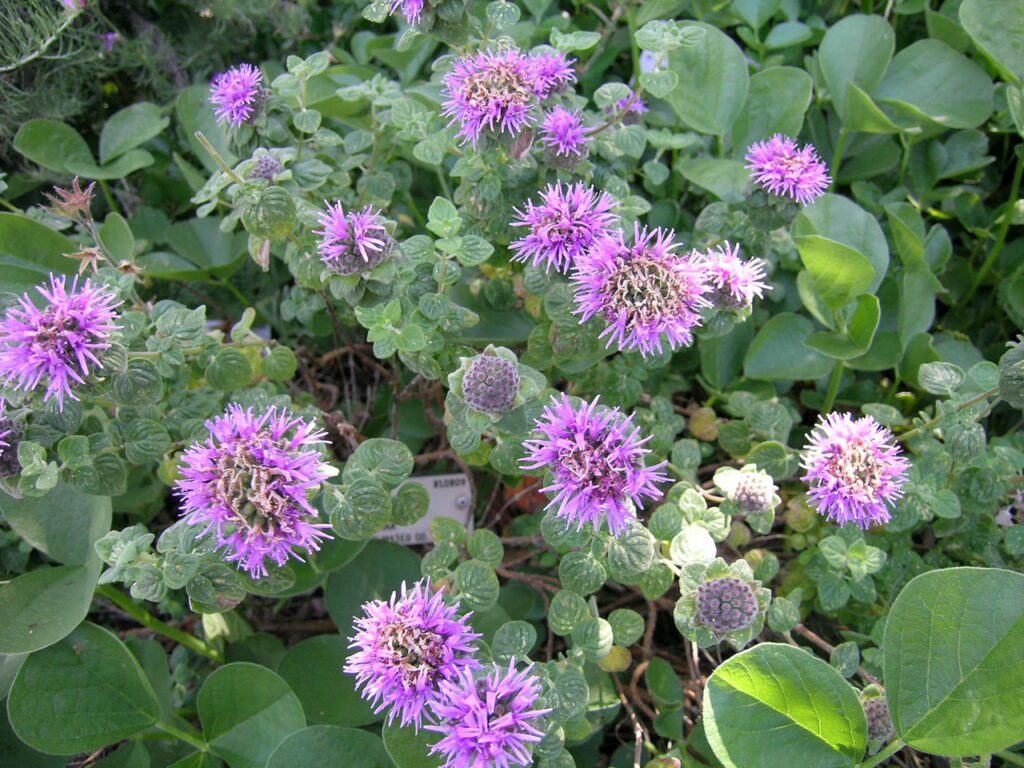
8
Purple Sage, Salvia leucophylla pink. Evergreen shrub, 2 to 5 feet tall, 3 to 10 feet wide. Full sun, very low moisture. Fuzzy grayish leaves with puckered surface. Large spikes have clusters of purple flowers. Supports bees and butterflies. Mixed with bear fat as an all purpose salve. Used for coughs, colds, fevers, stomach aches. An edible herb.
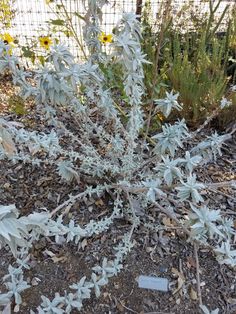
9
Nude Buckwheat, Eriogonum nudum long flower. Perennial shrub, .5’ to 1’ tall, .3’ to .6’ wide. Tall bare leafless stem topped with a white flower. 3” base, 1 to 6 foot tall bare stem with flower cluster on top. Full sun and very little water. Supports butterflies and caterpillars. Seeds were eaten or cooked with acorns. Leaves and stems made tea to treat coughs, colds, and as a laxative.

10
Wild Buckwheat, Coast Buckwheat, Eriogonum latifolium. Small mounted perennial herb, 2’ tall, 2’ to 3’ wide. Full sun to part shade, low moisture. Pale white-green oval wooly leaves. Cluster of white or pinkish flowers at the end of erect stem branch. Attracts bees, butterflies, and birds. Cold and cough medicine.
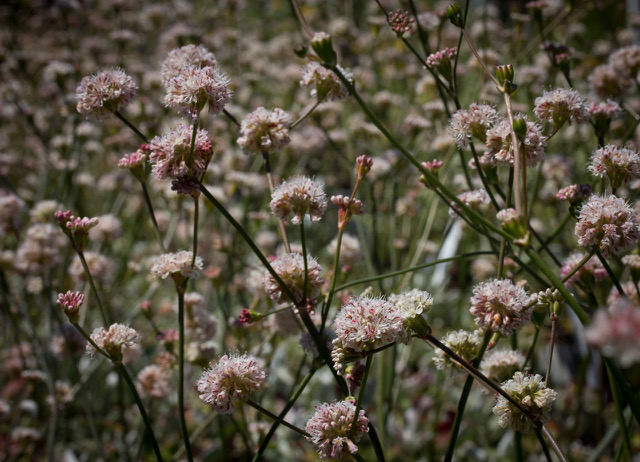
11
Snowberry, Symphoricarpos, existing. Deciduous shrub, pink flowers, white fruit, light green leaves up to 2” long, 3 to 4 feet tall and wide, full or partial sun. Used as an external wash on the skin.
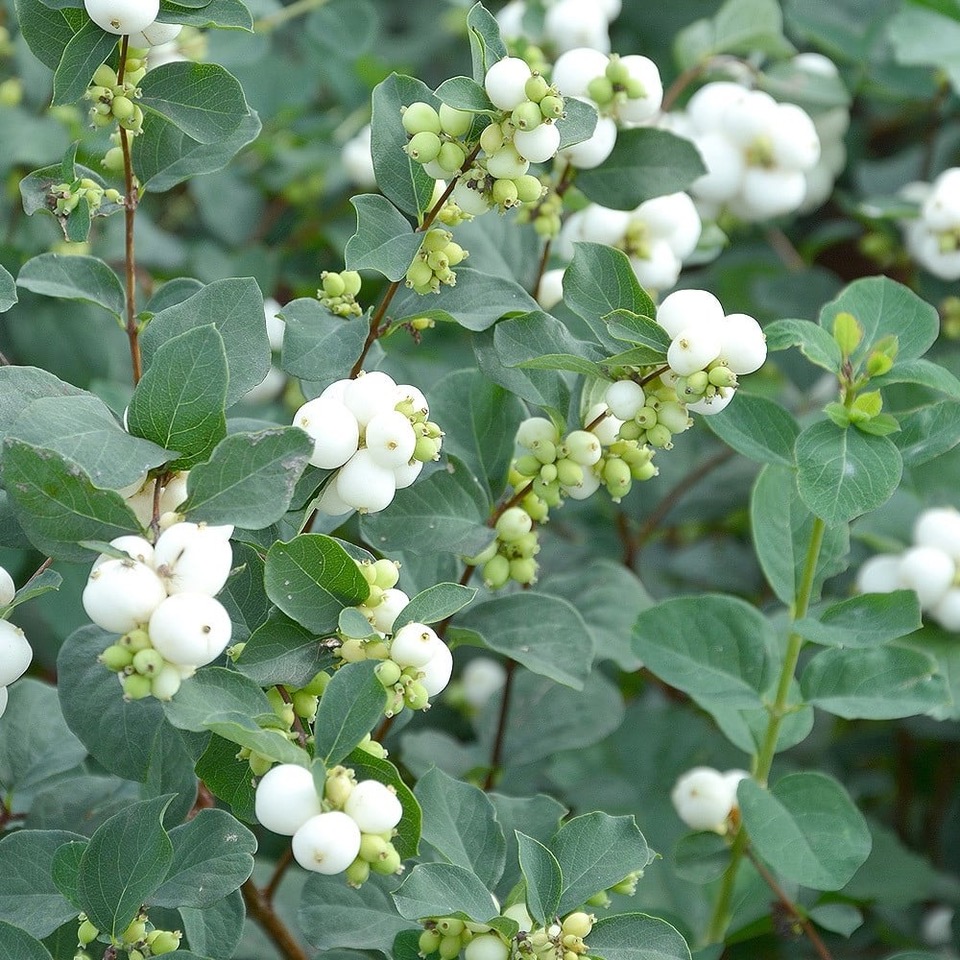
12
Yarrow, Achillea millefolium. Showy flower heads with many tightly packed little flowers. Ferny foliage. Needs dry soil, full sun. Strong sweet scent. Used as a wash to treat sunburn. Remedy for anxiety and stress, pain, bleeding, colds, insomnia

13
Showy Milkweed, existing, Asciepias speciasa. Erect clump-forming perennial with spherical clusters of fragrant pinkish white starry flowers. Broad leaves. 4’ tall and slender, full sun. Attracts monarch butterflies and hummingbirds. Host for butterfly larvae. Cooked for food. Sap used to treat warts, roots for dysentery. Treatment for coughs, typhus, asthma. Stalks make string and rope.
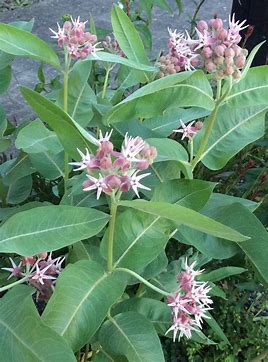
14
Woodland Strawberry, Fragaria vesca. Perennial groundcover, 3” to 9” high and 9” to 12” wide with tiny bright red strawberries. Full to part sun with moist, well drained soil. Native to both Europe and North America. Leaves, stems, and flowers used as herbal medicine or herbal tea, aids in treatment of diarrhea. Strawberries as food.
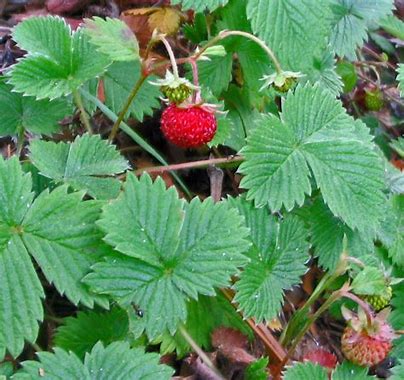
15
Evergreen Current, Ribes vibernifolium. Perennial shrub, 2’ to 3’ tall, 8’ wide, sun or part shade, very low moisture. Shiny dark green leaves on top, lighter green and leathery on the bottom. Dark red stems. Good under oaks. Sticky citrus scented sap. Deep red blooms in spring attract butterflies, small red fruit attracts birds. Could not find documented use by Native Americans.
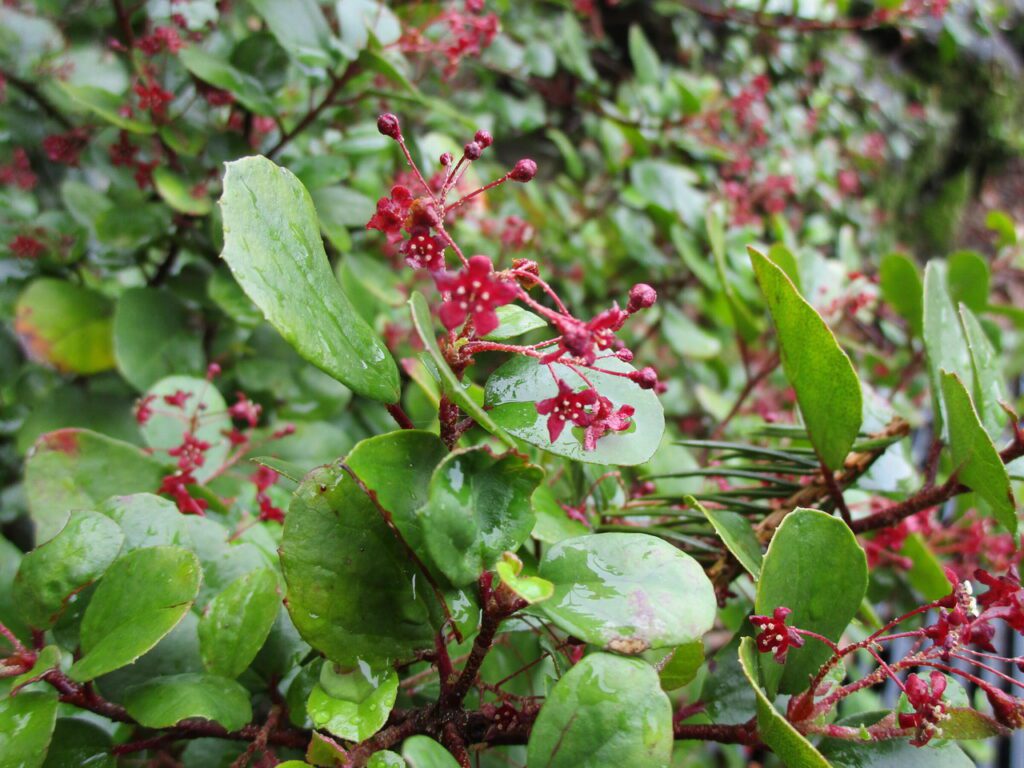
16
Claremont Pink Flowering Currant, Ribes sanguineum. Shrub 6’ to 8’ tall, 4’ to 6’ wide, part shade, low moisture. Leaves are 5 lobed, similar to maple leaves, crinkly, and finely haired on the underside. Fruits are blue-black. Pendulous clusters of pink flowers in spring. Essential nectar source for bees and hummingbirds. Berries were eaten fresh but not considered tasty.
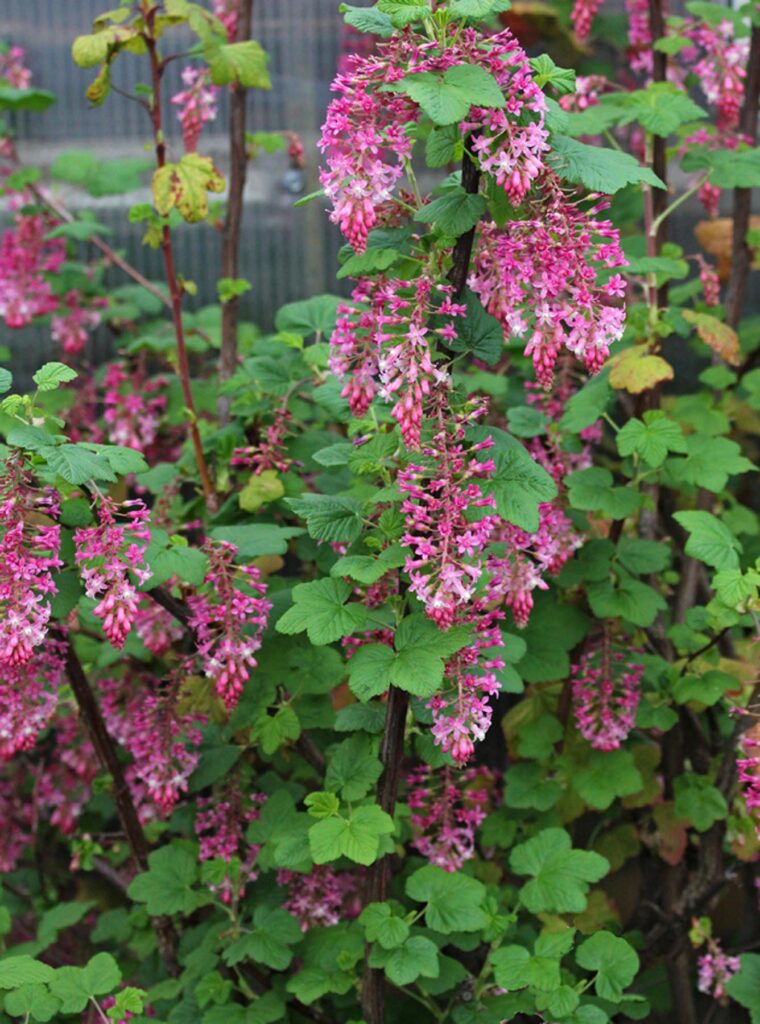
17
California Barberry, Berberis pinnata. Evergreen shrub 3’ to 7’ tall, 5’ wide, part sun to full shade, low moisture. Holly like wavy edged leathery leaves. Blue-black fruit. Dense clusters of right yellow flowers in spring. Fruit is edible but a bit sour and filled with seeds. Used for purple die. Bark prepared for treatment of fever, rheumatism, and dysentery.
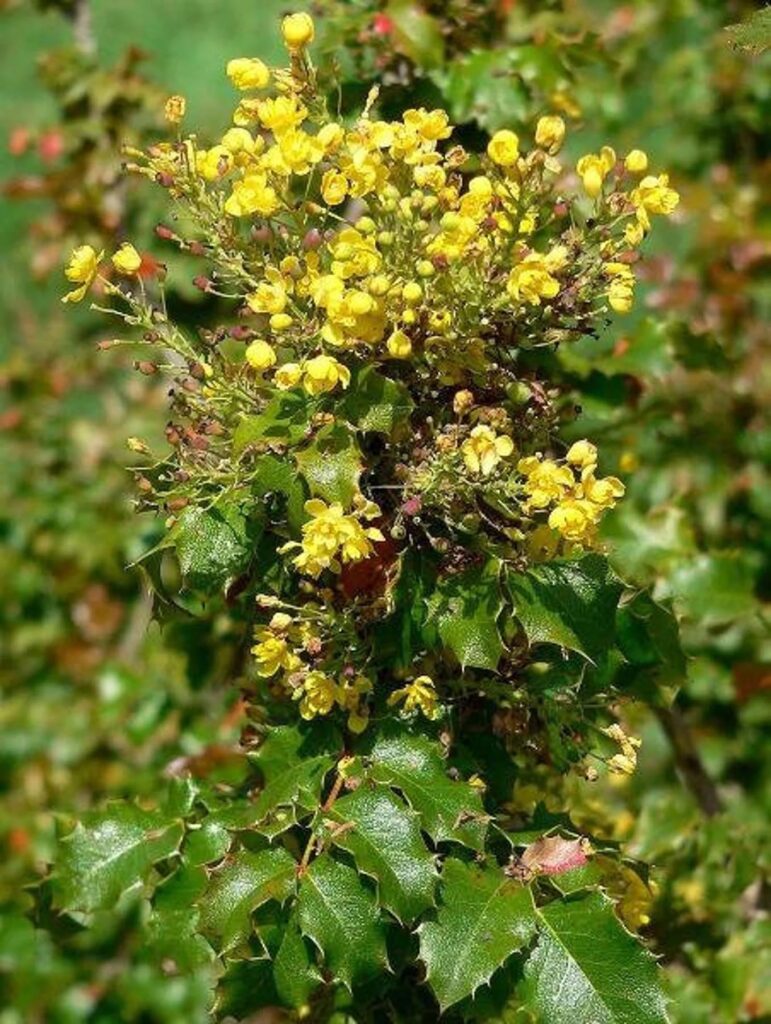
18
Golden Rod, Solidago velutina (or californica). Perennial evergreen. Full sun to part shade, medium moisture. A main stalk with no branches, 1.5’ to 5’ tall. Spearhead shaped serrared leaves 6” long by 1” wide. Tiny yellow flower masses at the top on multiple long stems. Flowers summer and fall. Rhizome roots. Plants can be aggressive and invasive. Attracts butterflies, bees, and insects. Used as medicine for sore throat, fever, chest pains, rheumatism, neuralgia, bee stings, bladder and kidney ailments, jaundice, toothaches, and diaarrhea. Used to make tea and as a flavoring for other medicines. Used as a dye.
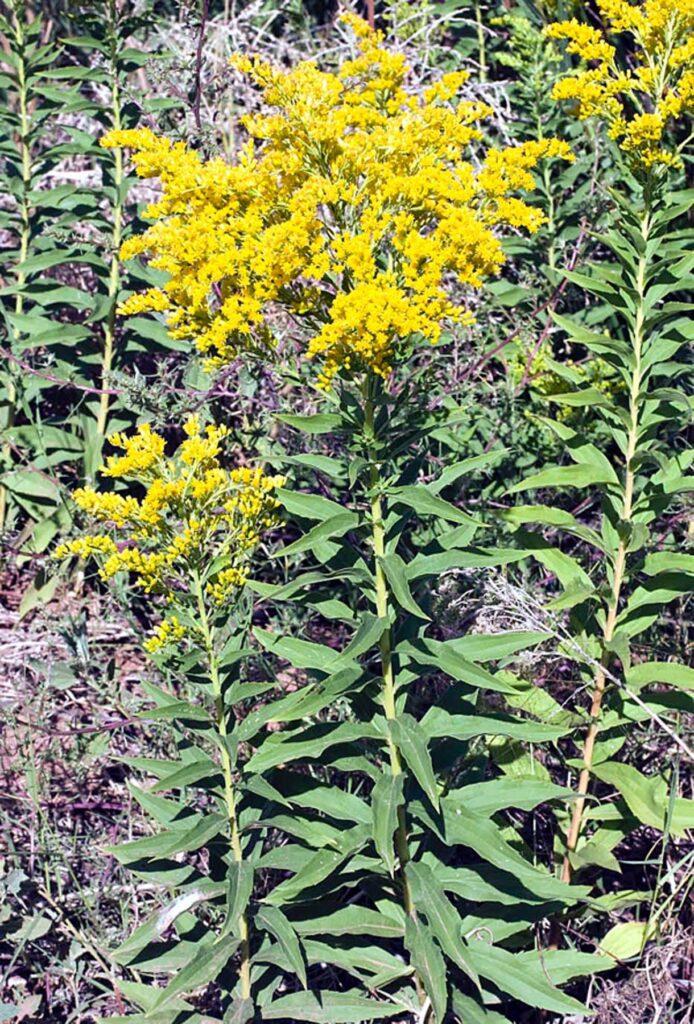
19
Manzanita existing, low growing groundcover.

20
Toyon, Heteromeles arbutifolia. Evergreen small tree., 6’ to 8’ tall but can reach 25’. Sun or part shade, drought tolerant and can grow in poor soil. Small white flowers bloom in summer. Pea sized red berries, poisonous to humans when eaten fresh. Berries used to make a jelly. Leaves used for tea as a stomach remedy.
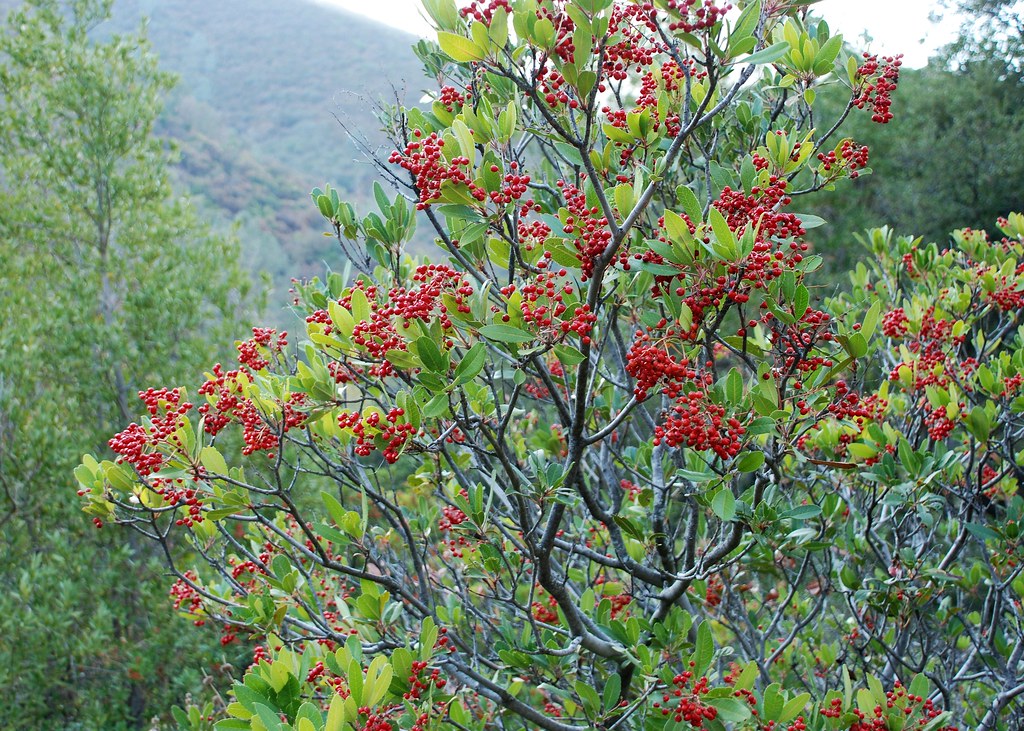
21
Bee Plant (California Figwort), Scrophularia californica. Tall gangly evergreen pererennial 3’ to 6’ tall, 2’ to 3’ wide, part shade in moist soils. Trianguar bright green leaves up to 7” long. Tiny red-brown flowers blooming in mid spring to mid summer. Prolific nectar attracts bees, hummingbirds, and butterflies. Caterpillars consume leaves. Medicinal uses include treatment for mouth and throat conditions, cysts, fibroid tumors, inflammation, and poultices for burns, sores, and wounds.
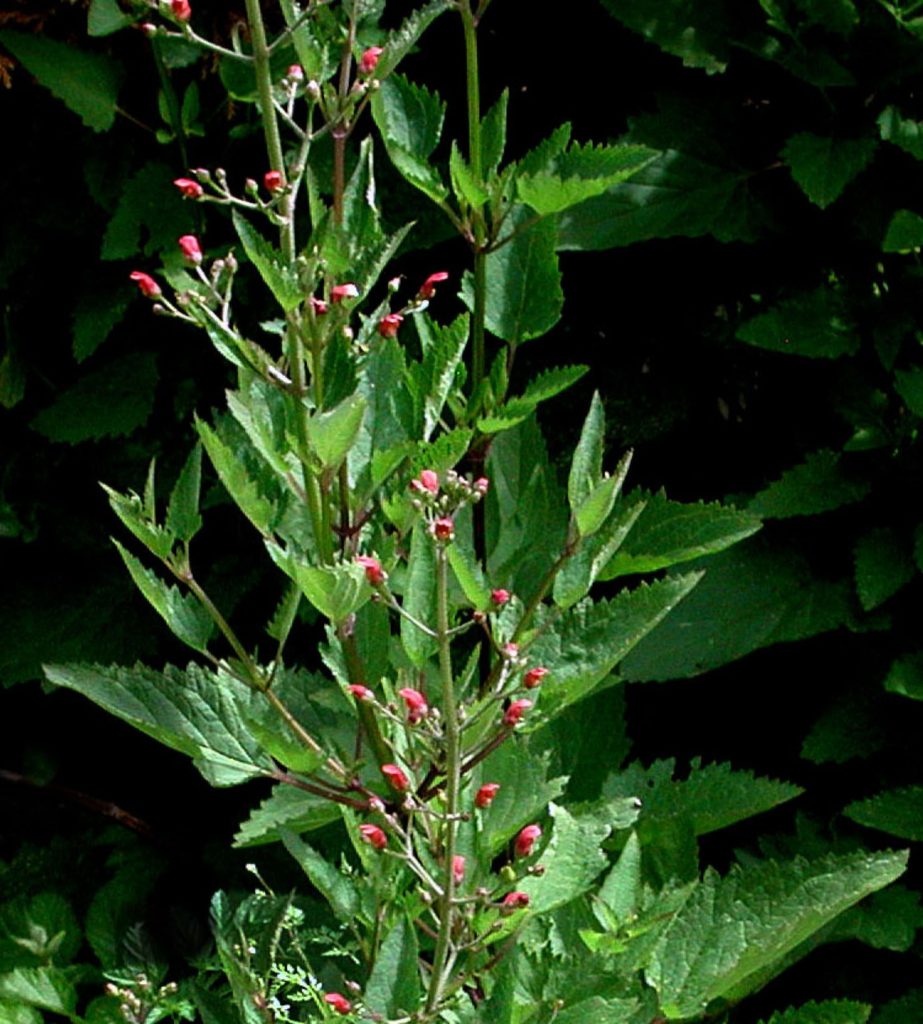
22
Giant Chain Fern, Woodwardia fimbriata. Tall evergreen fern. Part or full shade, high moisture. Very long fronds reaching 4’ to 8’. Very little use for wildlife. Used for lining or covering food storage baskets and cooking vessels, and for making baskets.
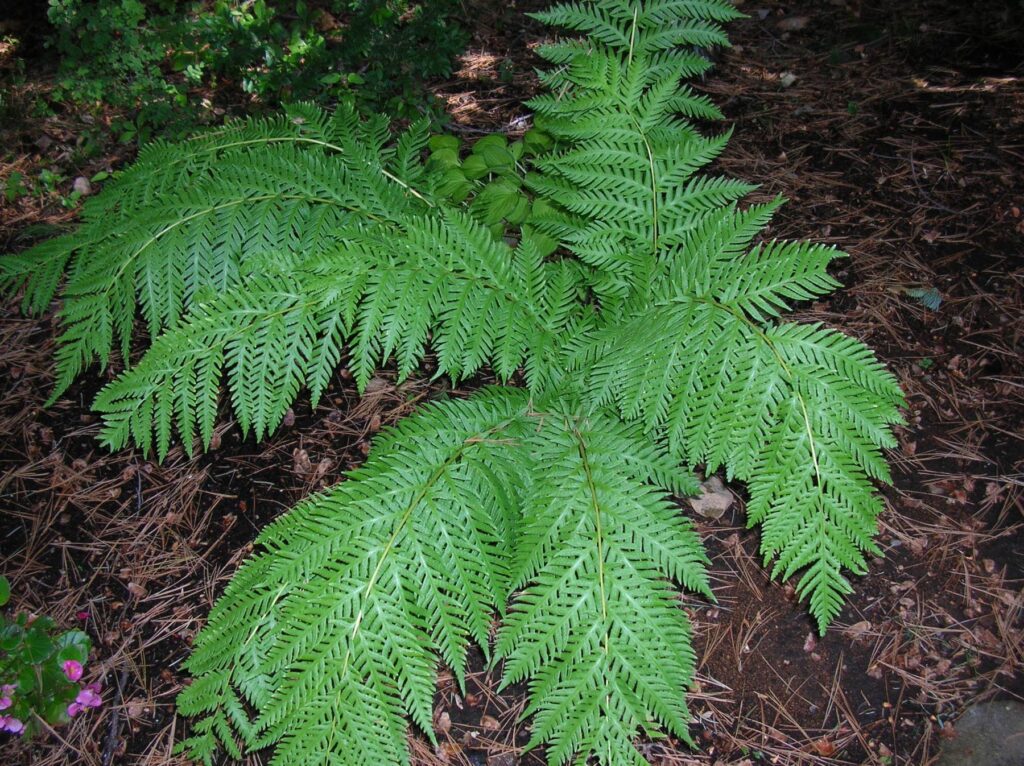
23
Island Alum Root, Heuchera maxima. Rhizomatous perennial herb 1’ to 2’ tall, 2’ wide, full shade to full sun, low moisture. Large rounded multilobed green leaves with a fringe of hairs on the edge. Erect flower clusters with many clusters of tiny hairy pink or cream colored flowers. Hummingbirds love the flowers. Root was pounded and used to treat sores and swellings.
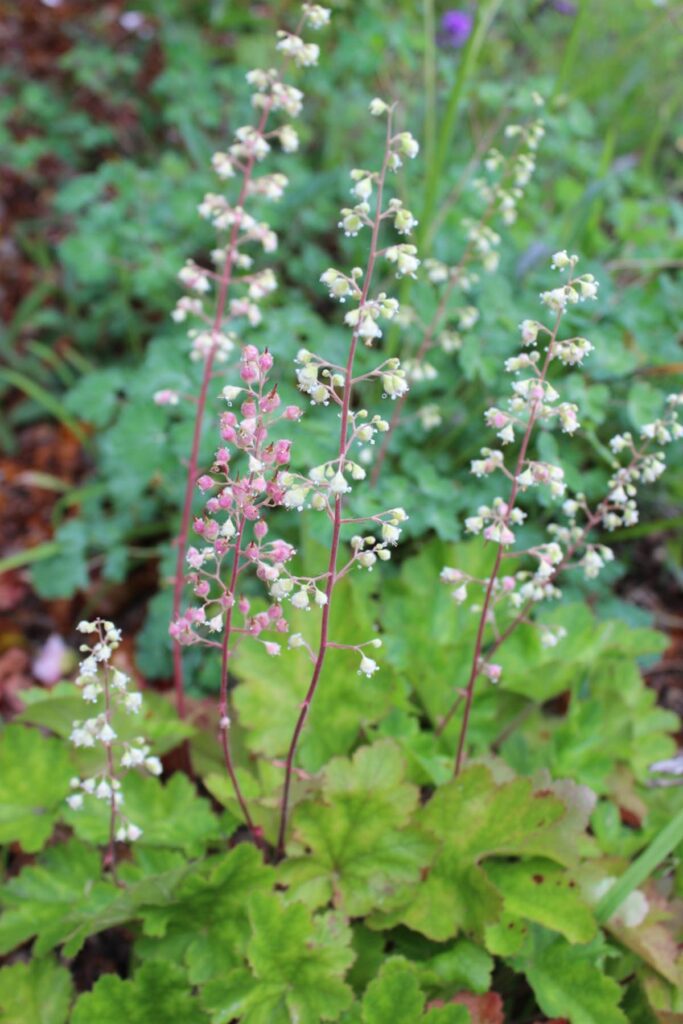
24
Redwood Sorrel, Oxalis oregano. Creeping rhizomatous perennial ground cover. 6” tall, part shade, high moisture. White or pink flowers, 5 petals. Velvety mid-green clover-like leaves. Supports butterflies and moths. Used as food, both raw and cooked with tangy lemony flavor.
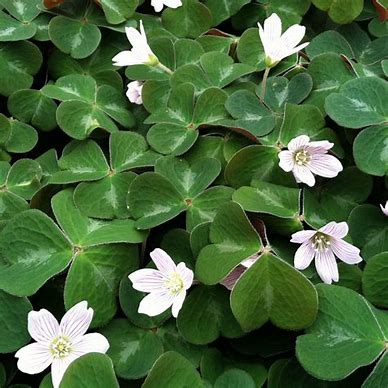
25
Ceanothus, species unknown, could be one of 50 or 60 species. Range from 1.5’ to 10’ tall.
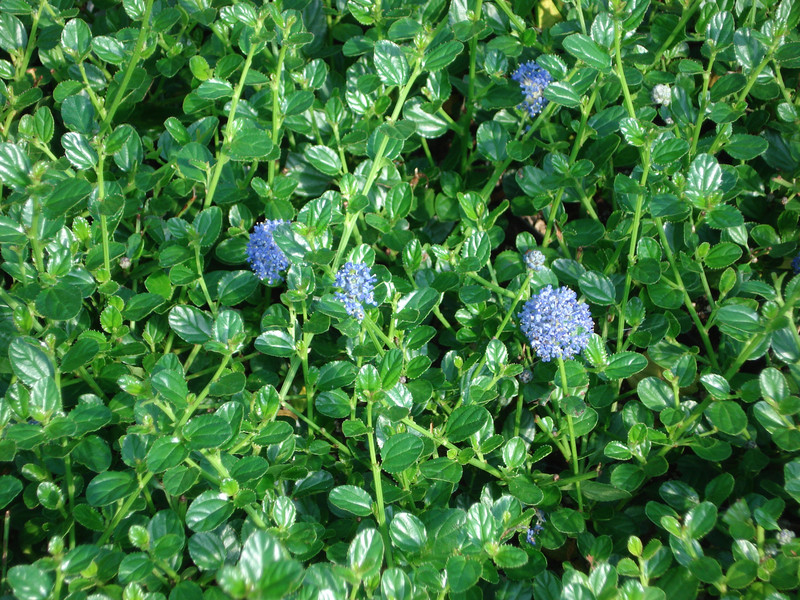
26
California Fuchia, Epilobium canum. Low growing spreading semi-evergreen perennial. 3” to 1.5’ tall, full sun or part shade, very low moisture. Narrow lance shaped velvety gray-green leaves. Bright scarlet flowers in summer and autumn. Supports hummingbirds and butterflies. Used as a detergent in washing, dusting powder for cuts and sores. Used for treatment of tuberculosis, kidney and bladder infections.
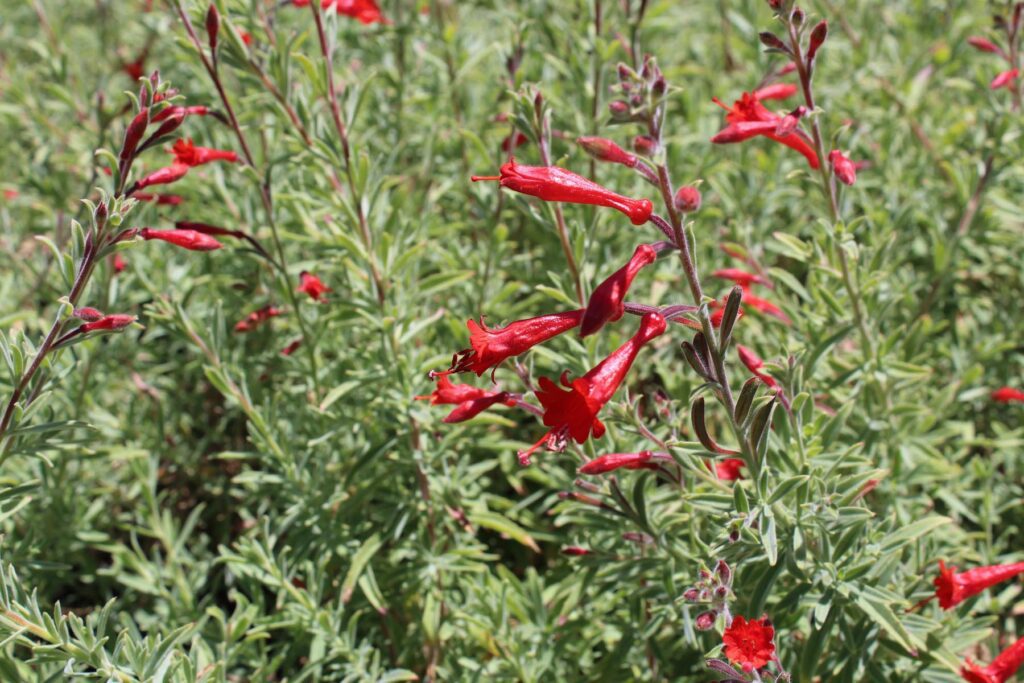
27
Columbine, Aquilegia pubescens. Perennial herb, .5’ to 1.5’ tall, shade or part shade. Showy erect flowers are yellow, white, or pink. Supports birds and butterflies. Very small amounts used for treatment of ulcers.
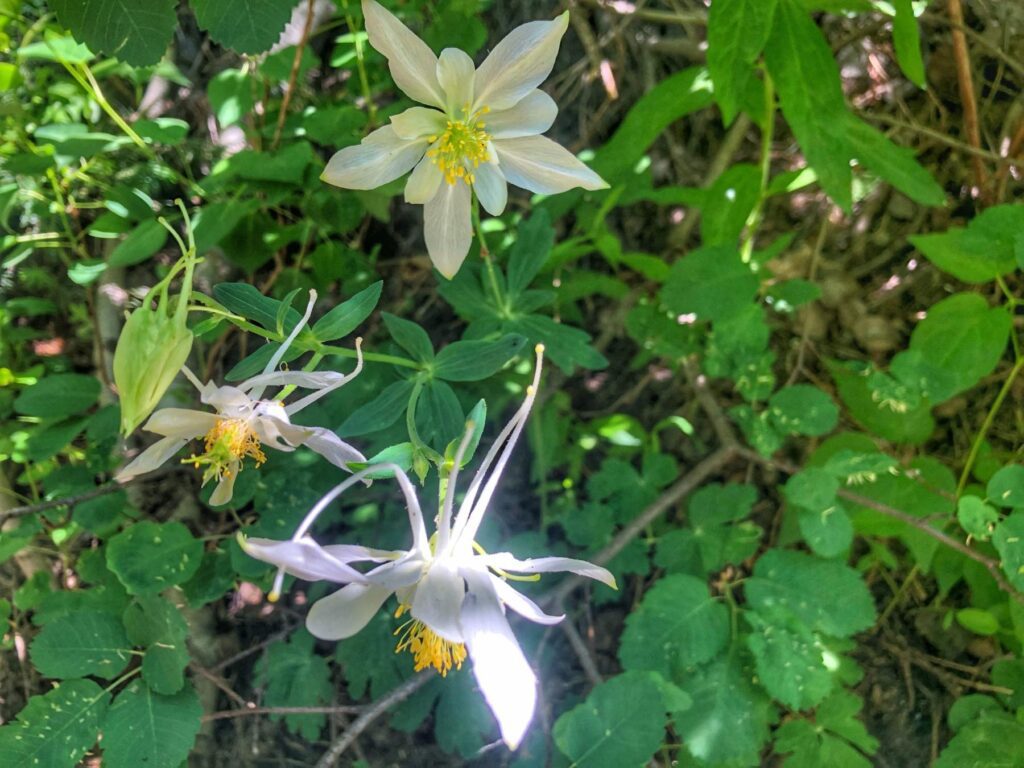
28
Pacific Willow, Salix lucida lasiandra. Deciduous tree, 15’ to 30’ tall and wide, full sun to part shade, moderate to high moisture. Supports butterflies. The long supple branches were used to frame their rounded buildings, up to 20’ in diameter
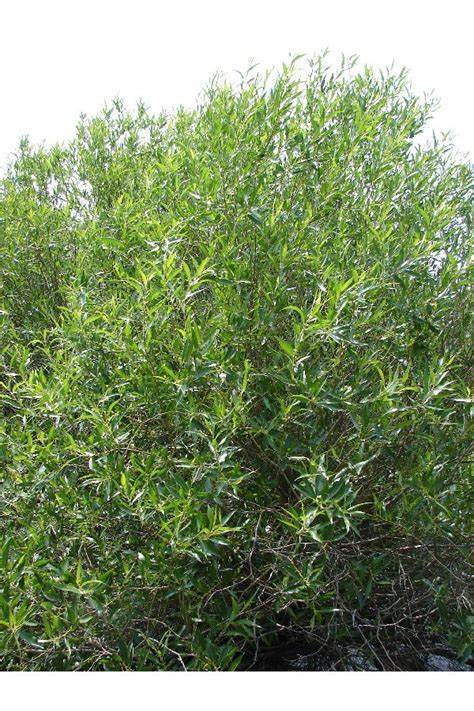
29
Beach Strawberry, Fragaria Chiloensis. Perennial herb spreading groundcover, 1’ to 4’ tall, 2’ to 3’ wide, part shade or full sun, very low to low moisture. Small glossy green leaves, white flowers, small red strawberries. Strawberries are edible but not sweet. Edible fruit. Leaves used medicinally for burns.
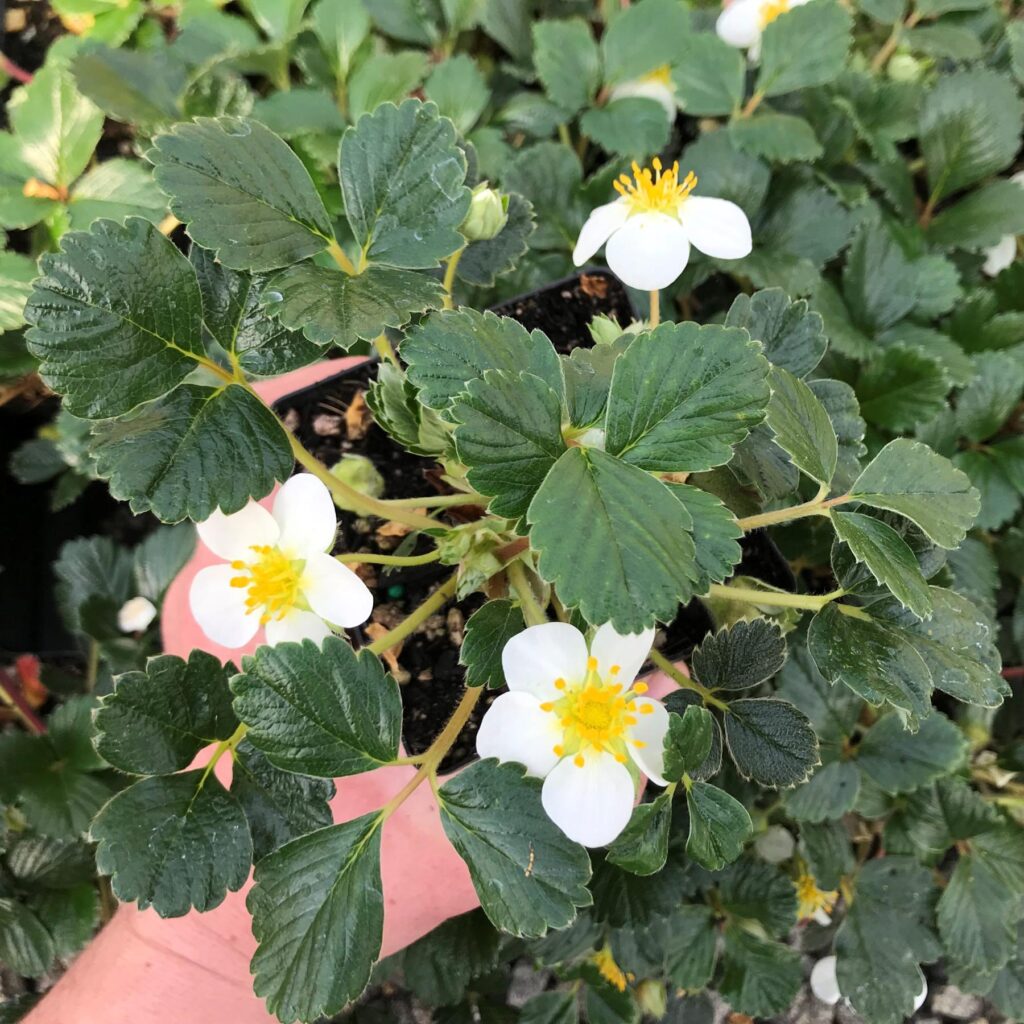
30
Bush Anemone, Carpenteria californica “Elizabeth.” Evergreen shrub, 5’ to 7’ tall, 4’ wide, upright. White flowers with 6 petals, yellow stamen, in masses, in spring and summer. Light shade or morning sun, drought tolerant, low watering. Supports butterflies and bees. Native American uses are unknown according to one website. They are toxic if eaten. They may have medicinal uses as tincture in very low doses for anxiety, insomnia, and migraines
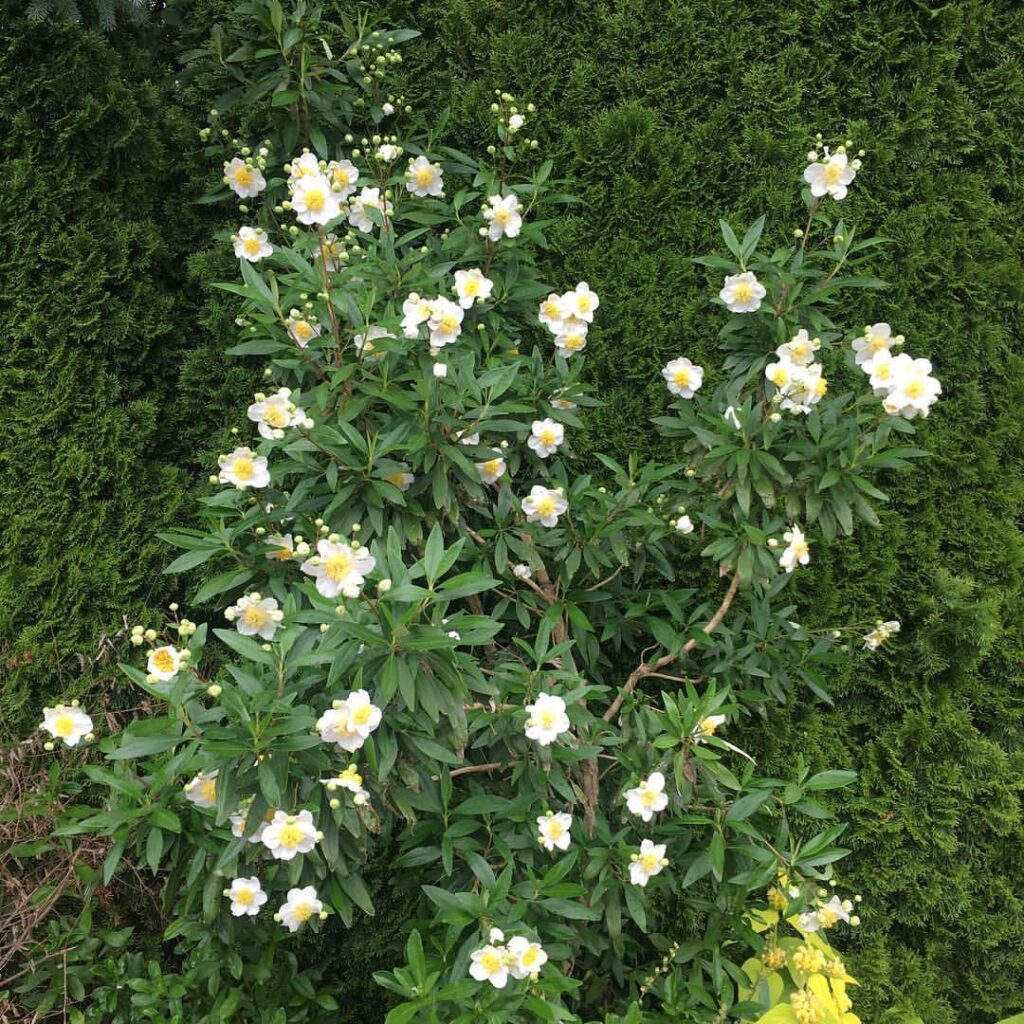
31
Red-osier Dogwood, Cornus sericia. Deciduous shrub 4’ to 9’ tall, 6’ to 9’ wide or more, full shade to full sun, moderate to high moisture. Supports birds and butterflies. Oval green leaves, small white flowers in bunches. Used for basketry. Tea from bark for medicinal purposes. Black, red, and khaki dye. Berries were dried and eaten.
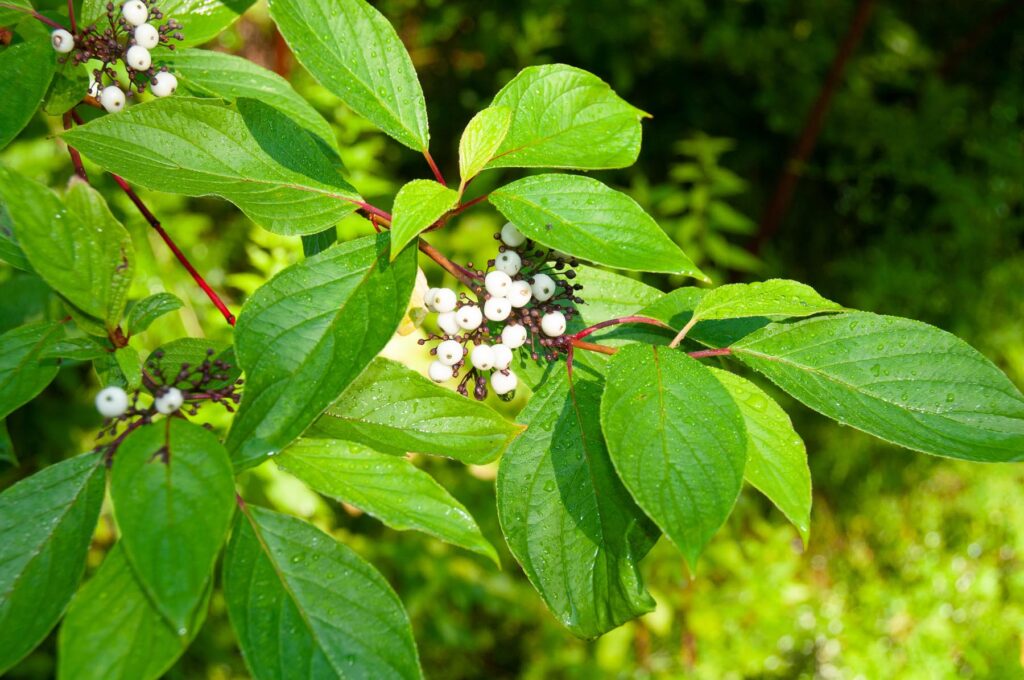
32
Fringe Cup, Tellima grandflora. Perennial herb for groundcover, 1.5’ to 3’ tall, 2” wide, shade or part shade, moderate to high moisture. Spikelike stems have red, pink, or white small bulb like flowers. Medicinal uses for mouth and throat conditions, cysts, fibroid tumors, inflammation. Poultice to treat burns, sore, and wounds. Root can stimulate kidney function.
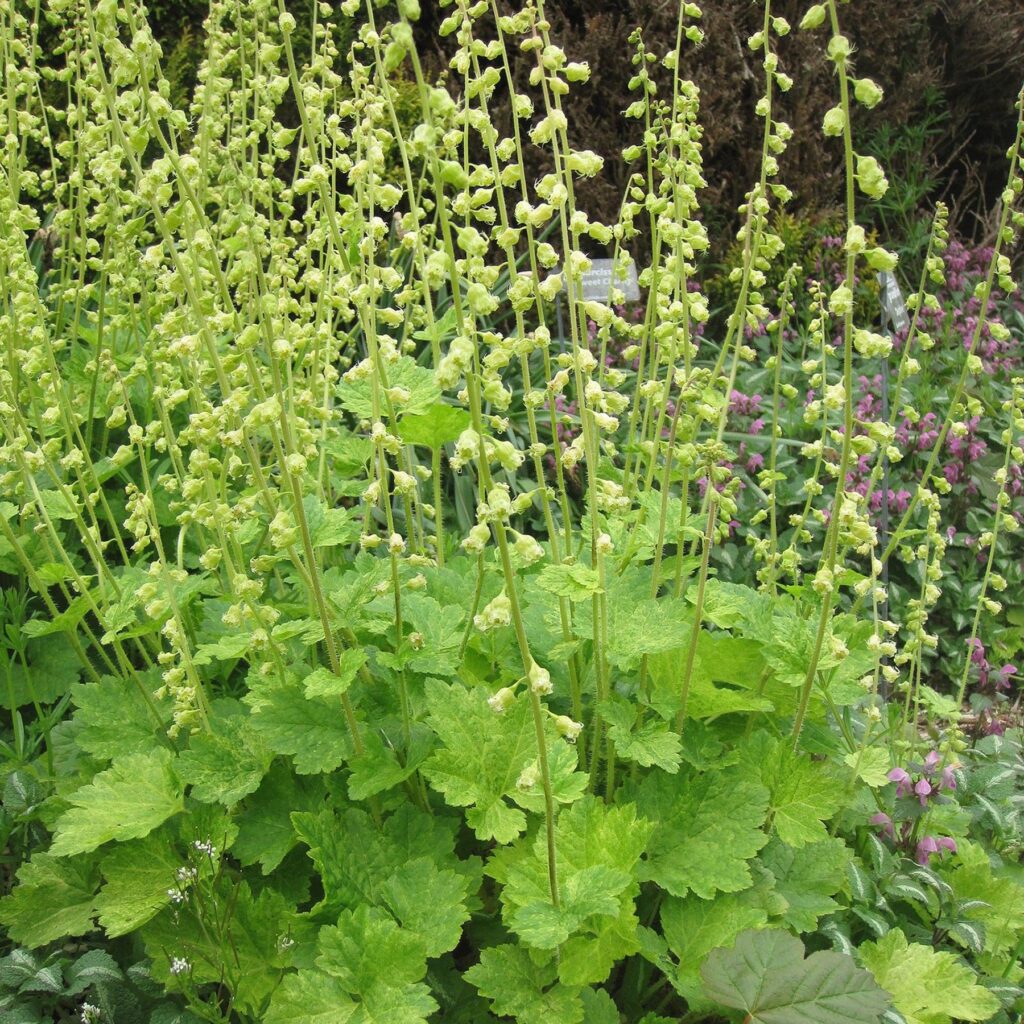
33
Douglas Iris, Iris Douglasiana. Purple wildflower, .5’ to 2.5’ tall, 2’ to 4’ wide, full sun to full shade, low moisture. Supports butterflies. Strong leaf fibers used for fish nets and to make rope. Roots made tea to induce vomiting, poultice to sooth sore eyes.
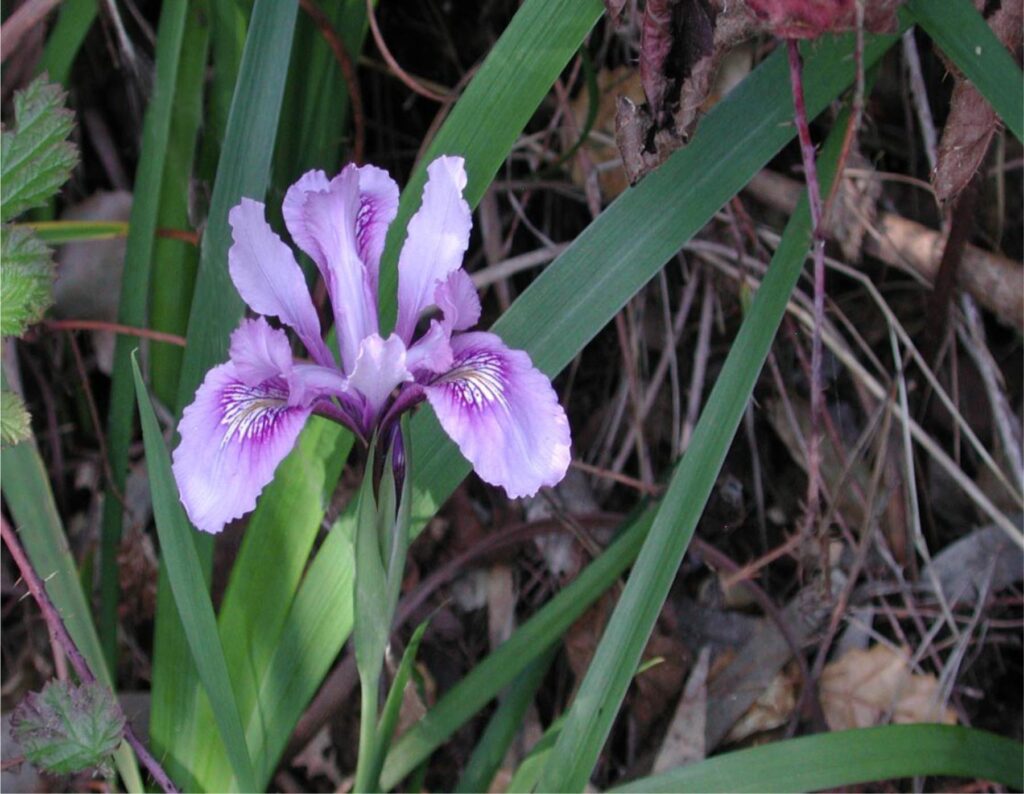
34
Ceanothus, species unknown, could be one of 50 or 60 species. Range from 1.5’ to 10’ tall.

35
Sticky Monkey Flower, Diplicus aurantiacus. Flowering perennial shrub, 4’ to 5’ tall, 5’ wide, full sun to part shade, low or very low moisture. Supports birds, hummingbirds, bees, butterflies. Numerous small orange-yellow flowers. Small, long and narrow, deep green sticky leaves. Medicinal use to treat wounds, skin irritation, and respiratory problems. Leaves and stems cooked or eaten raw.
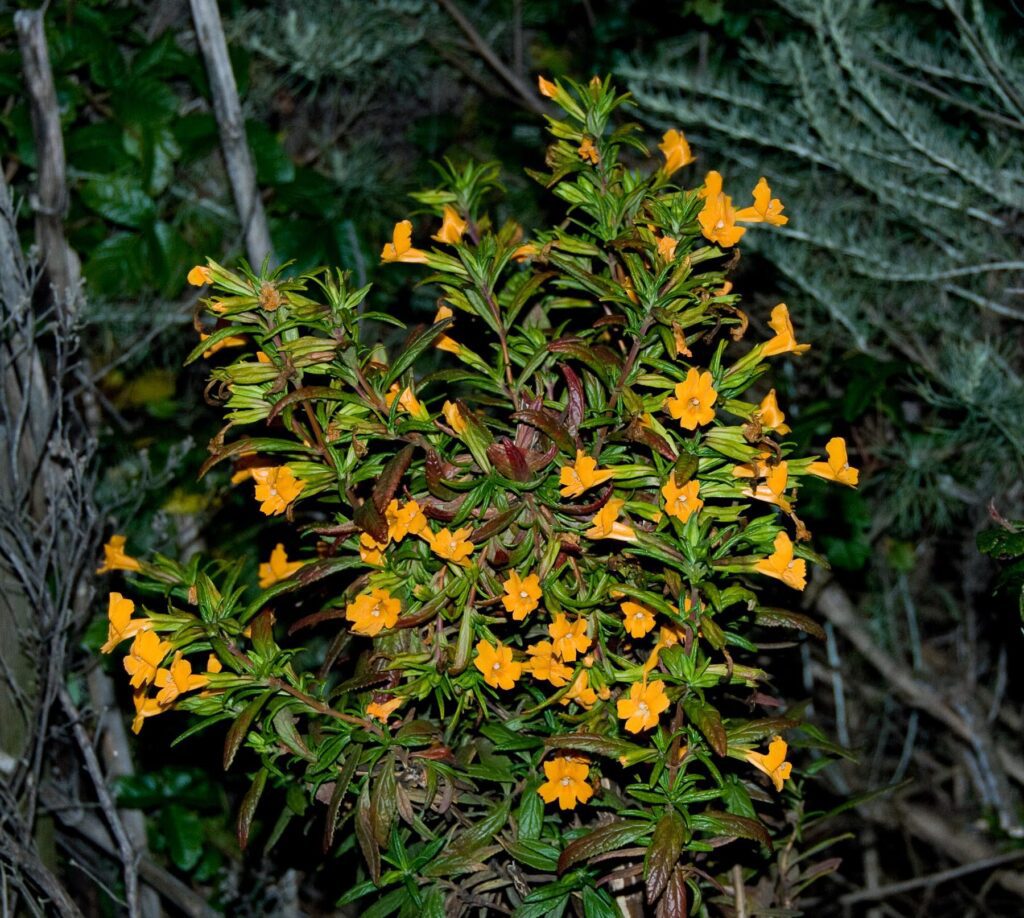
36
Soaproot, Chlorogalum pomeridiamum. Perennial herb 3’ tall, 1.5’ wide, full sun or part shade, very low moisture. Grows from a bulb covered in thick coarse fibers. Long wavy leaves grow from the base horizontal outward. Very small white flowers grow on long vertical stems. Leaves could be eaten. Bulb was roasted as a food. Bulb used as soap and especially shampoo. Bulb was made into a brush with bulb as the handle and fibers as the brush. Bulb made into glue to fasten feathers to arrows. Cut up bulbs could be thrown into a stream to stun fish for gathering. Medicinal uses for rheumatism and stomach aches.
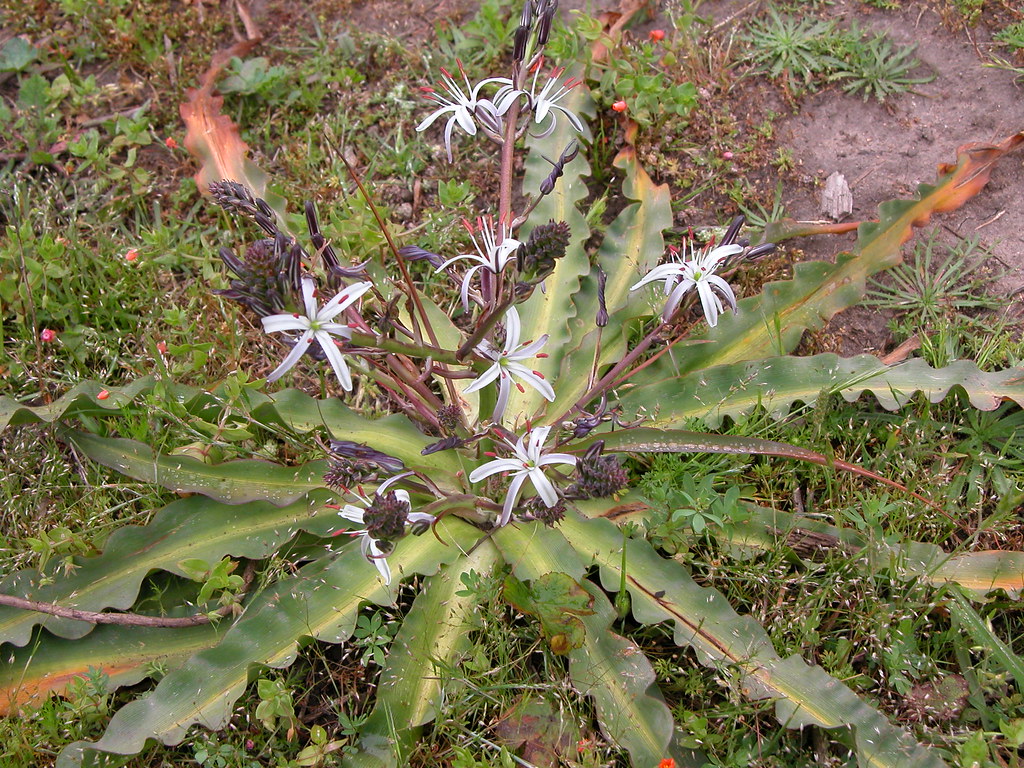
37
Japanese Pieris, Pieris japonica. Evergreen low maintenance shrub 3’ to 13’ tall that thrives in part shade. Bronze to green blade like leaves. Showy bud like flower bunches in spring. Poisonous. Native to Japan, China.

38
Japanese Mahonia, Mahonia japonica. Evergreen shrub 5’ to 7’ tall, leathery spiked dark green leaves, long upright yellow flower clusters in fall, blue-black berries. Native to China.
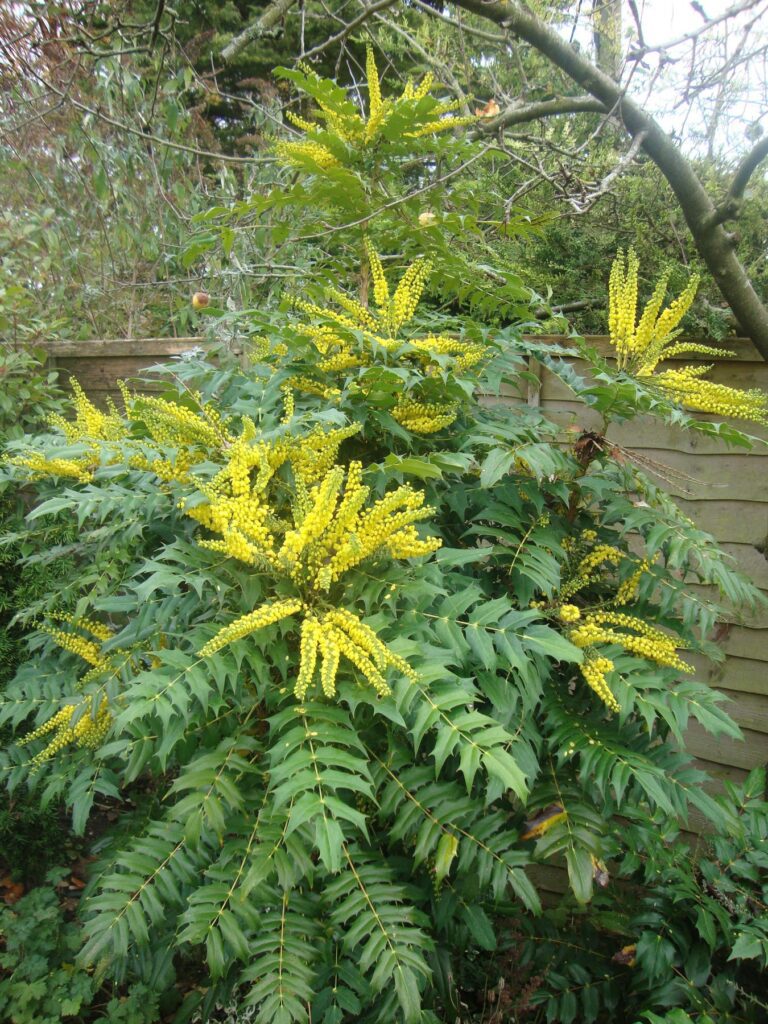
39
Lace Leaf Japanese Maple, Acer palmatum seiryu. Short tree in the soapberry family. 10 to 15 feet tall and 8 to 12 feet wide.
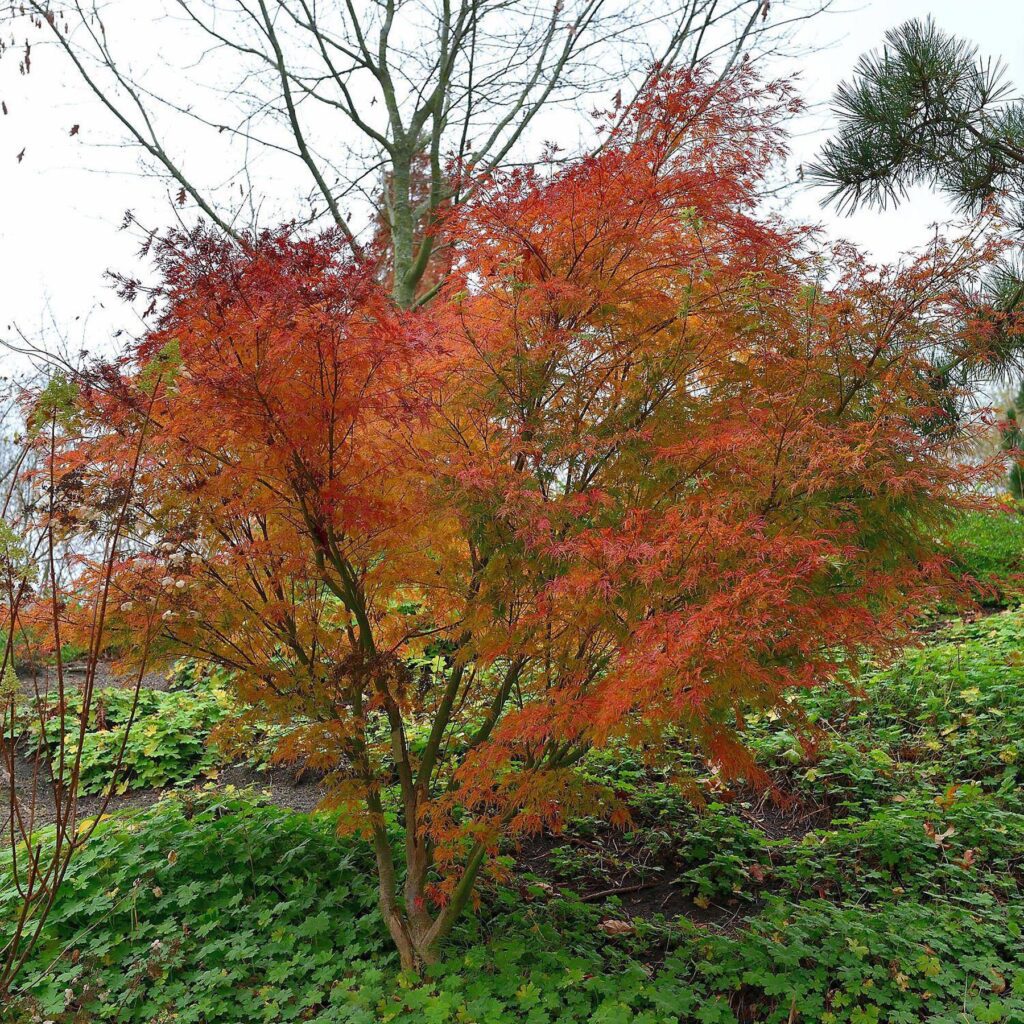
40
Japanese Hinoki Cypress, Chameacyparis obtuse. Tree up to 100’ tall. Native to Japan.
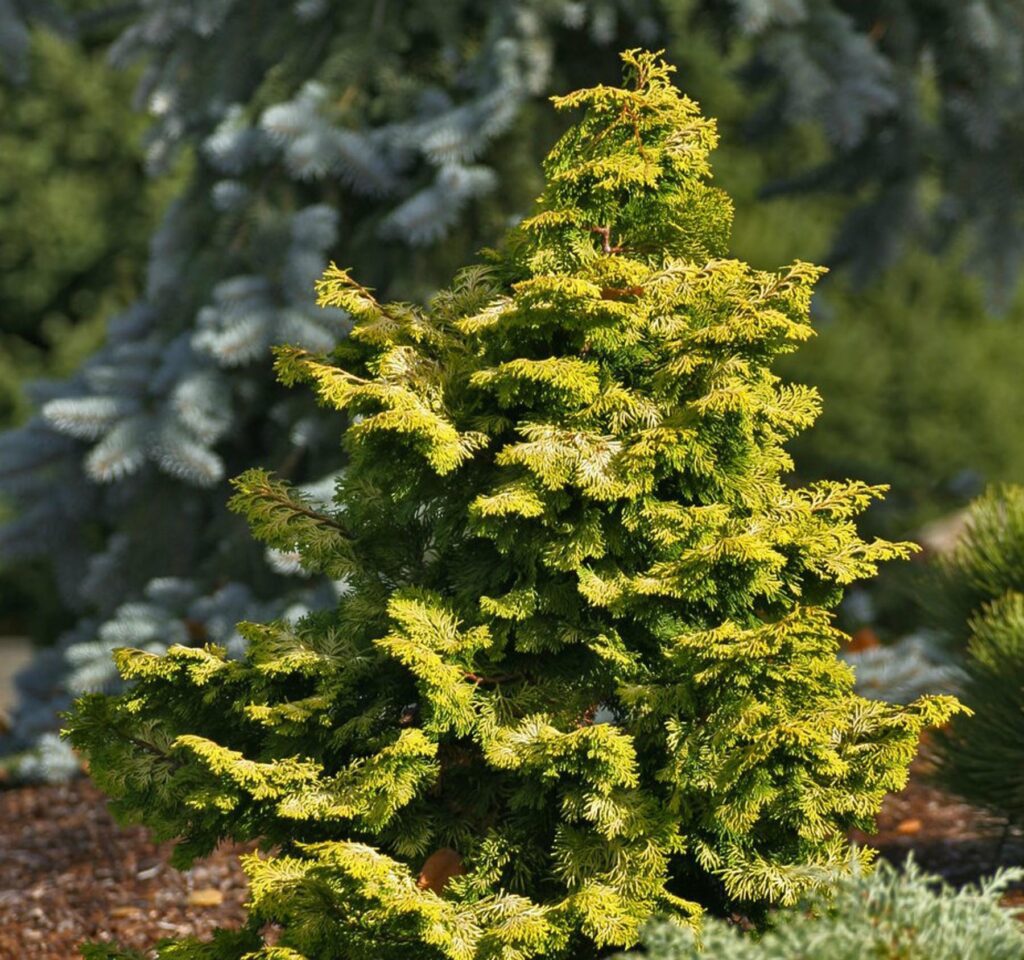
41
Japanese Azalea, Rhododendron japonicum. Small evergreen shrub up to 5’ high and wide. Massive flowering in spring of various colors, white, pink, red, or purple.
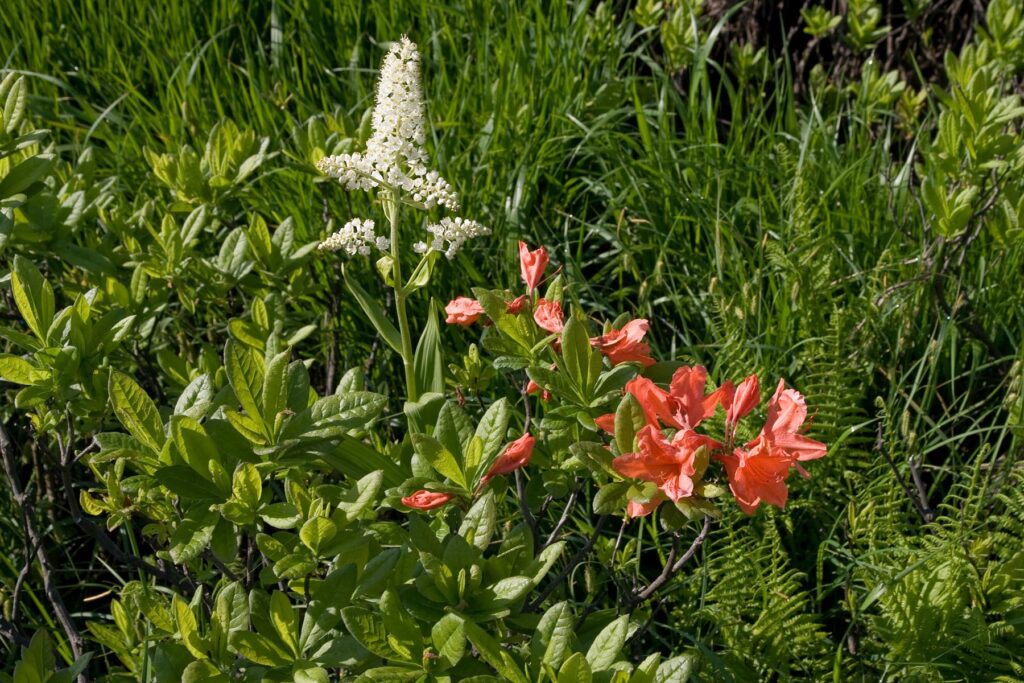
42
Oregon Grape, Berberis aquifolium. Evergreen shrub, 3.5’ to 7’ tall, 6’ wide, full sun to full shade, low moisture. Dark green holly shaped leaves turn red-purple in fall. Dense clusters of yellow flowers in spring. Purple berries. Used for medicinal purposes including stomach problems, hemorrhages, tuberculosis, acne, herpes, arthritis. Also a food and dye.
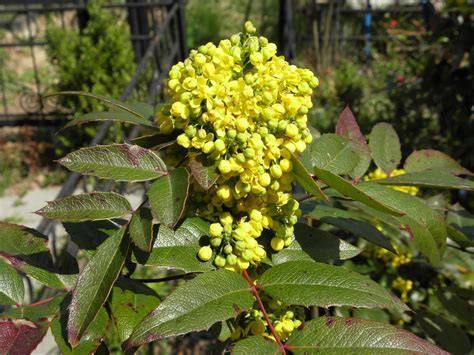
43
Douglas Iris, Iris Douglasii, purple. Purple wildflower, .5’ to 2.5’ tall, 2’ to 4’ wide, full sun to full shade, low moisture. Supports butterflies. Slowly spreading rhizomatic evergreen perennial forming clumps of sword-shaped arching dark green leaves. Different than 33 above. Strong leaf fibers used for fish nets and to make rope. Roots made tea to induce vomiting, poultice to sooth sore eyes.
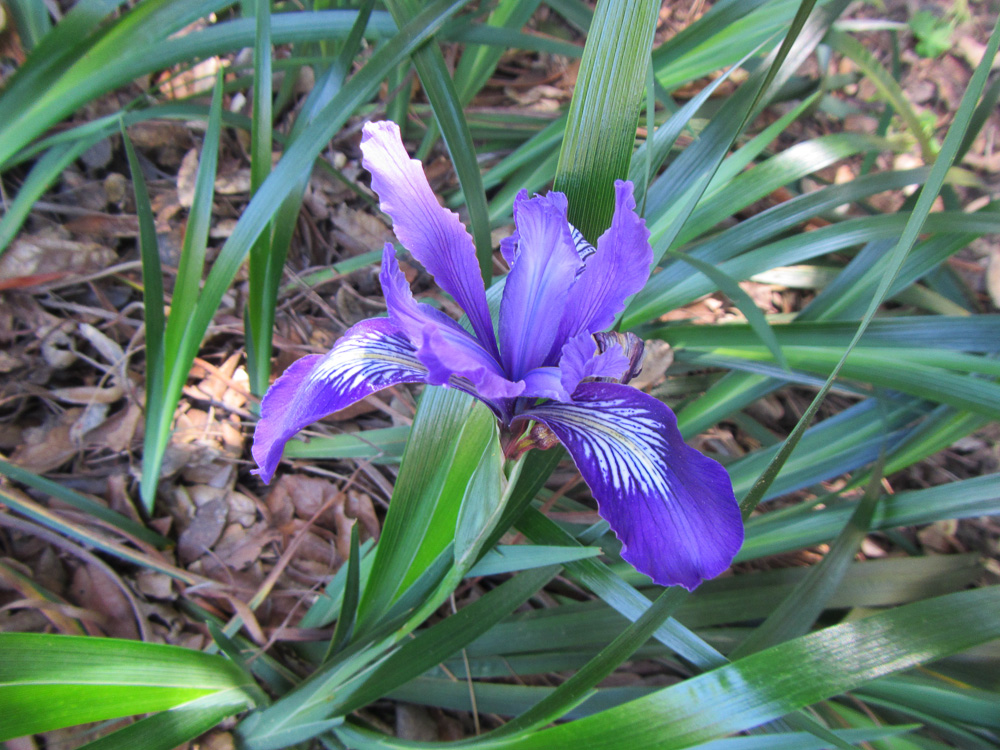
44
Western Labrador Tea, Rhodedendron columbianum. Evergreen shrub, 3’ to 5’ tall, shade, supports butterflies. Grows in wet area. Leathery oval shaped leaves, hairy-fuzzy on undersides. Cream colored flower clusters with 5 petals at end of stems, long protruding stamens. Used as food and medicine. Contains a toxin. Leaves used as tea. Used as astringent, diuretic, laxative. Repels moths, mice, rats.
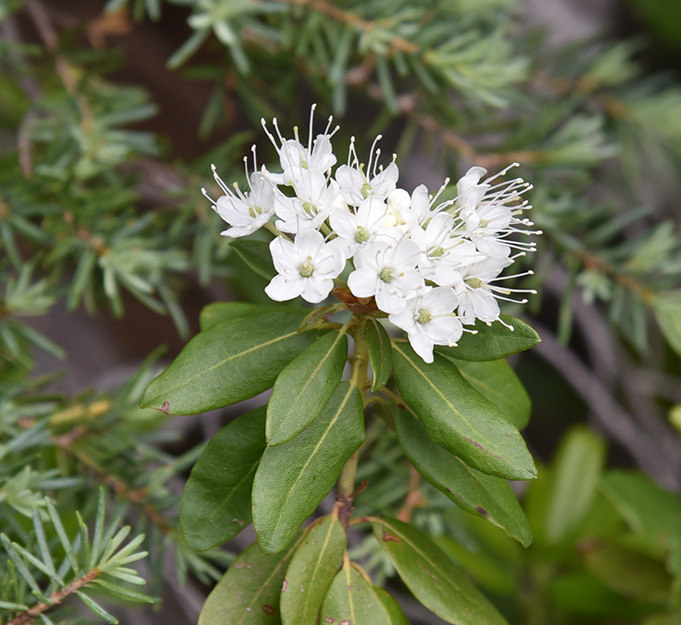
45
California Rosebay, Rhodedendron macrophylium. Broadleaf evergreen shrub growing 10’ to 15’ tall, part shade, moderate to high moisture. Supports butterflies. Purple or pink flowers. Used as a drug and ceremonial medicine, decorative.
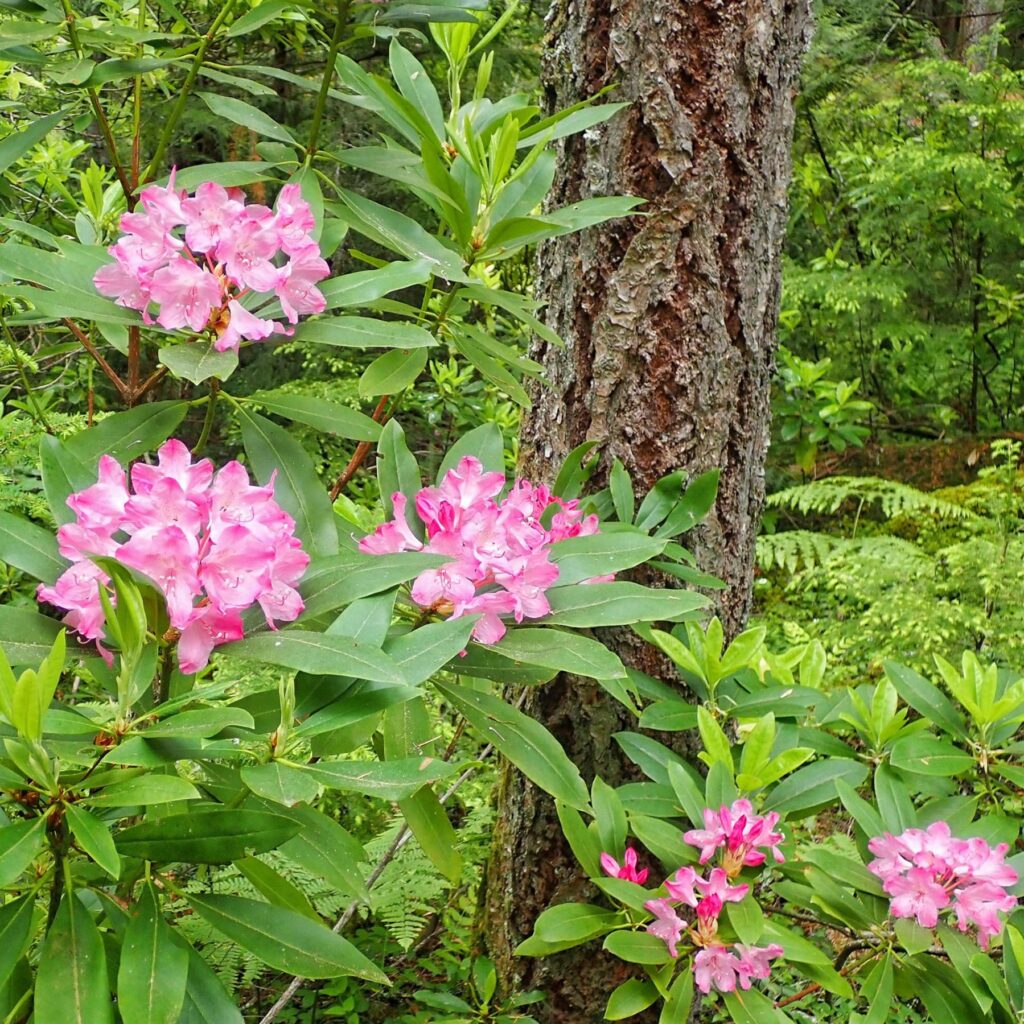
46
Japanese Mondo Grass, Ophiopogon japonicas. Evergreen groundcover with dense tufts of long dark green grasslike leaves, average moisture, full sun to part shade. Small flowers, blue berry like fruit. Native to China and Japan.
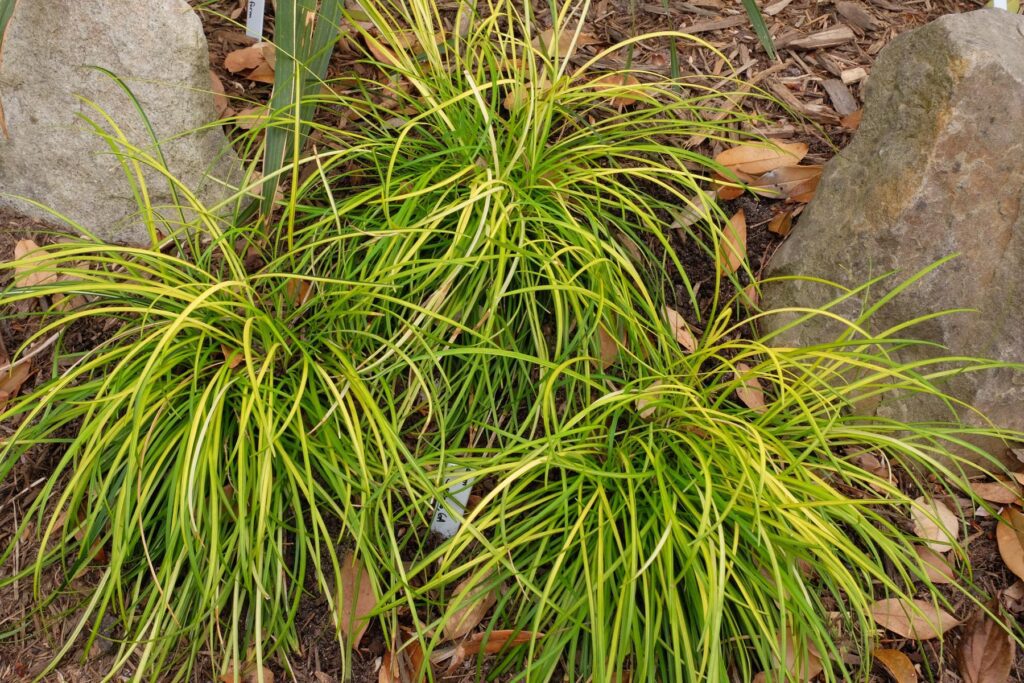
47
Spider Plant, Chlorophytum comosum. Long green and white leaves, very common houseplant, native to South Africa.
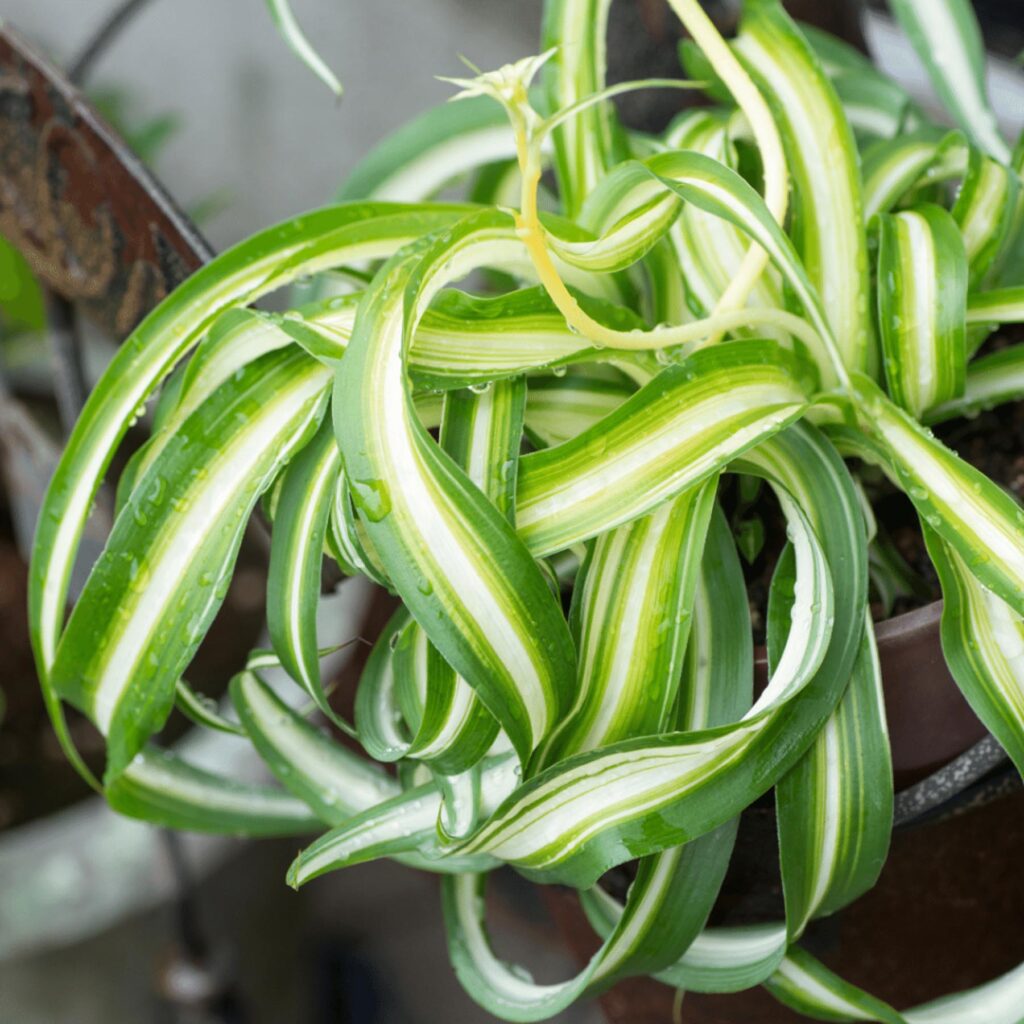
48
Unknown
49
Dawn Redwood, Metasequoia. Deciduous redwood tree, 100’ tall. Native to China.
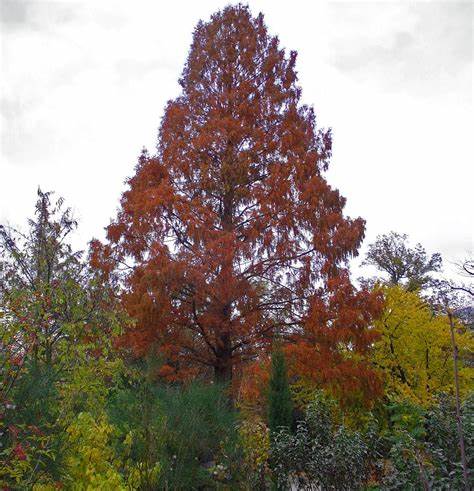
50
Salvia Royal Bumble (Mountain or Autumn Sage), Salvia greggii. Bushy evergreen shrub, 2’ to 3’ tall and wide, full sun, drought tolerant. Profusion of large brilliant red flowers, spring to fall, on purple-black upright stems. Glossy deep green leaves. Supports butterflies and hummingbirds. Not native to California.
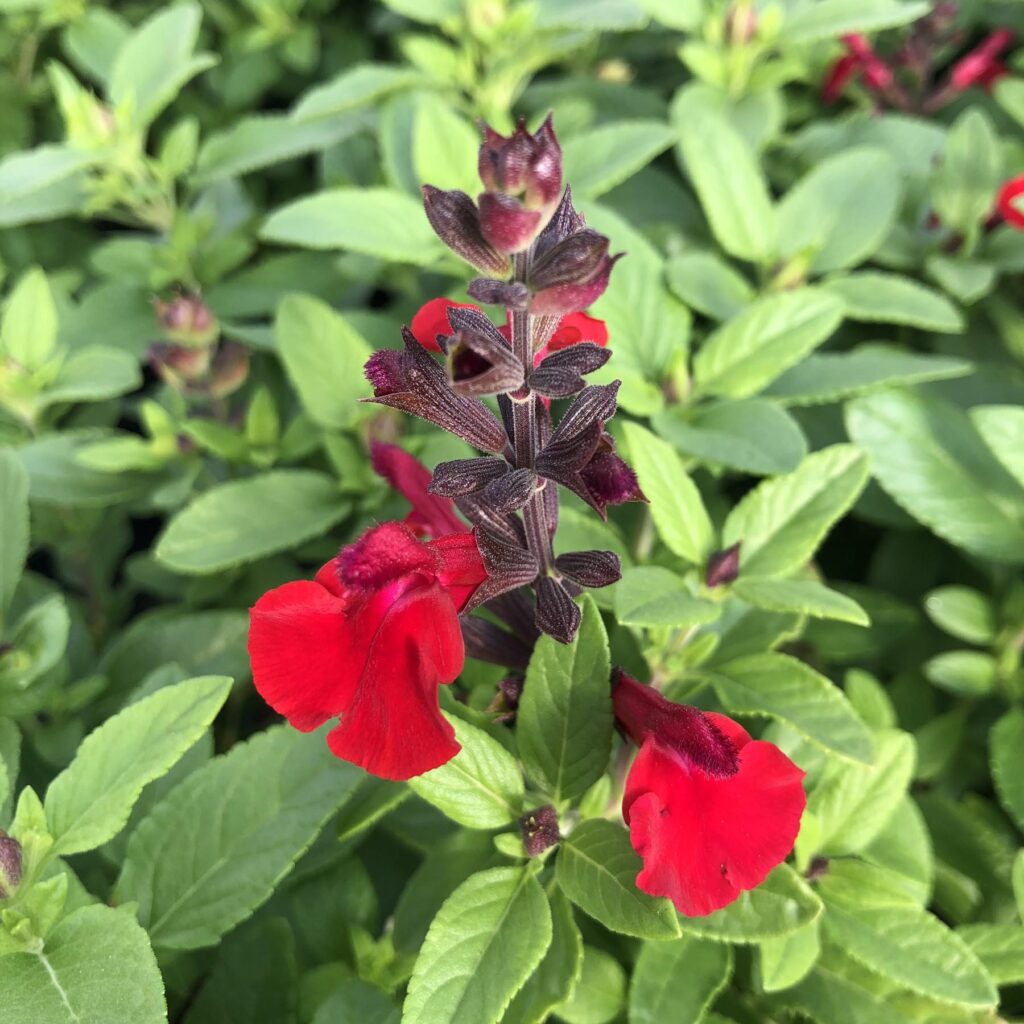
51
Western Sword Fern, Polystichum munitum. Evergreen fern, 1.5’ to 6’ tall, 2’ to 3’ wide, full sun to part shade, low to high moisture. Supports butterflies. Poultices of chewed leaves used to treat skin sores and boils. Rhizomes used for dandruff. Chewed leaves hastened childbirth and for sore throats or tonsillitis.
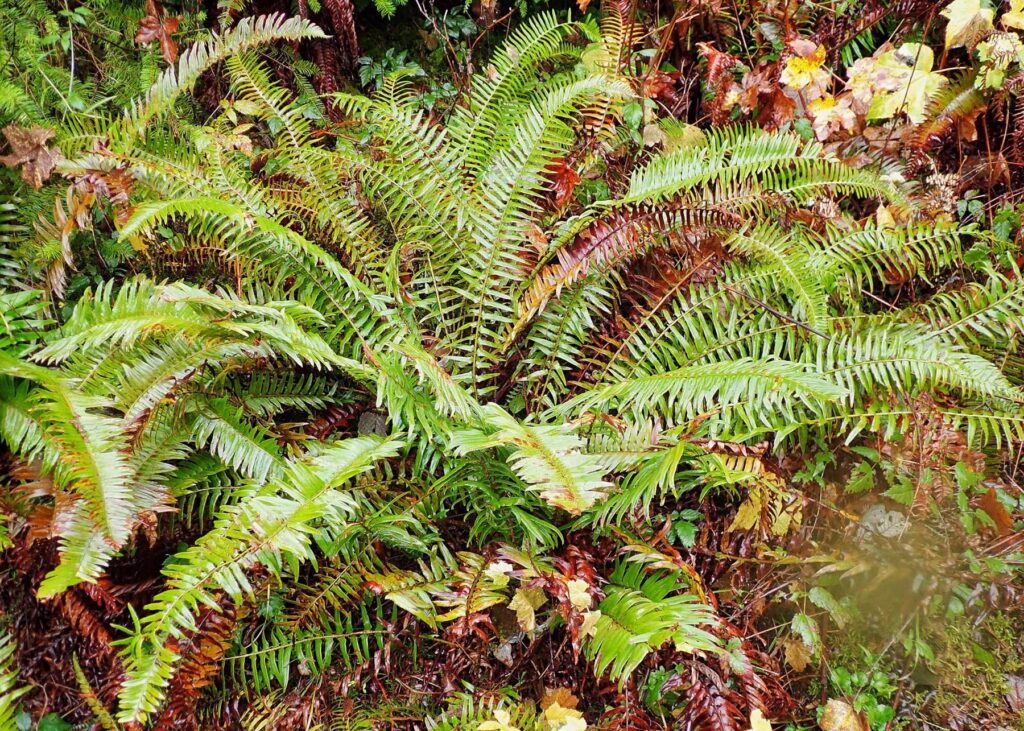
52
Narrowleaf Milkweed, Asclepias fascicularis. Flowering perennial herb, 1.5’ to 3.5’ tall, 1’ wide, full sun, low to high moisture. Thin erect stems with very narrow long pointed leaves. Clusters of lavender and lavender tinted white flowers. Host for Monarch butterflies. Sap used to make chewing gum. Added to salmon fat or deer grease.
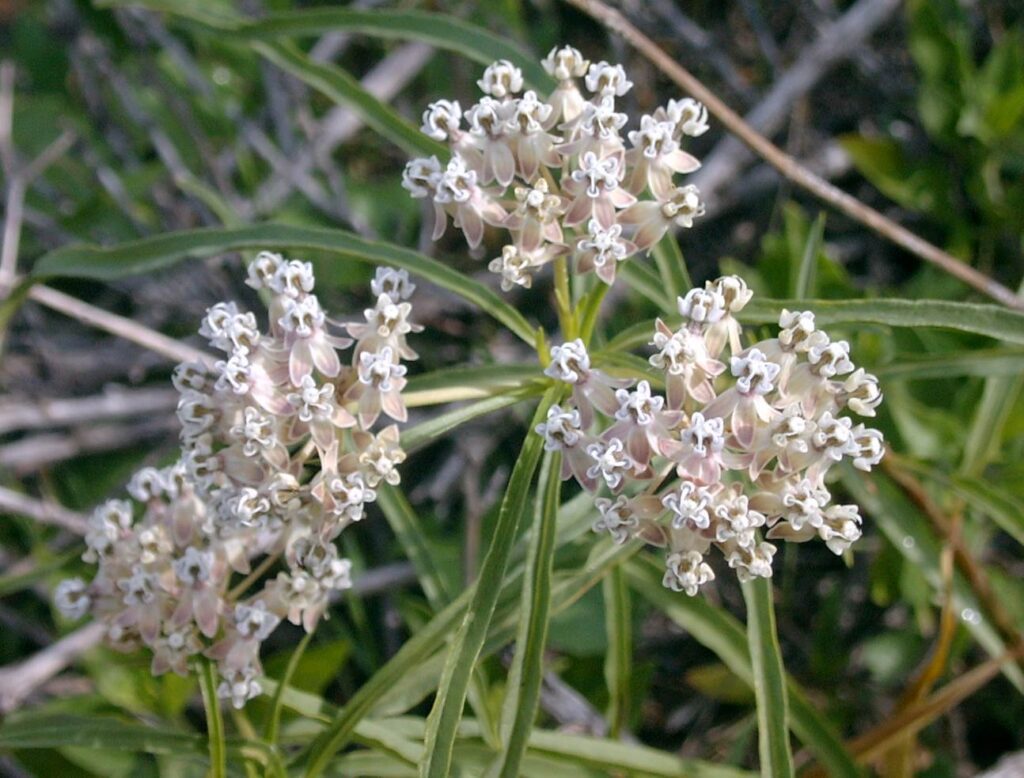
53
Buckbrush Ceonothus, Ceanothus cuneatus. Evergreen shrub ‘ to 12’ high and wide, upright, rounded, and spreading. Full sun, very low moisture. Supports butterflies and bees. Leaves are stiff, tough, fleshy, and may be slightly toothed on the edges. Bunches of tiny flowers, white, sometimes tinged with lavender or blue. Used for firewood and a variety of hunting and fishing purposes. Used for basketry.
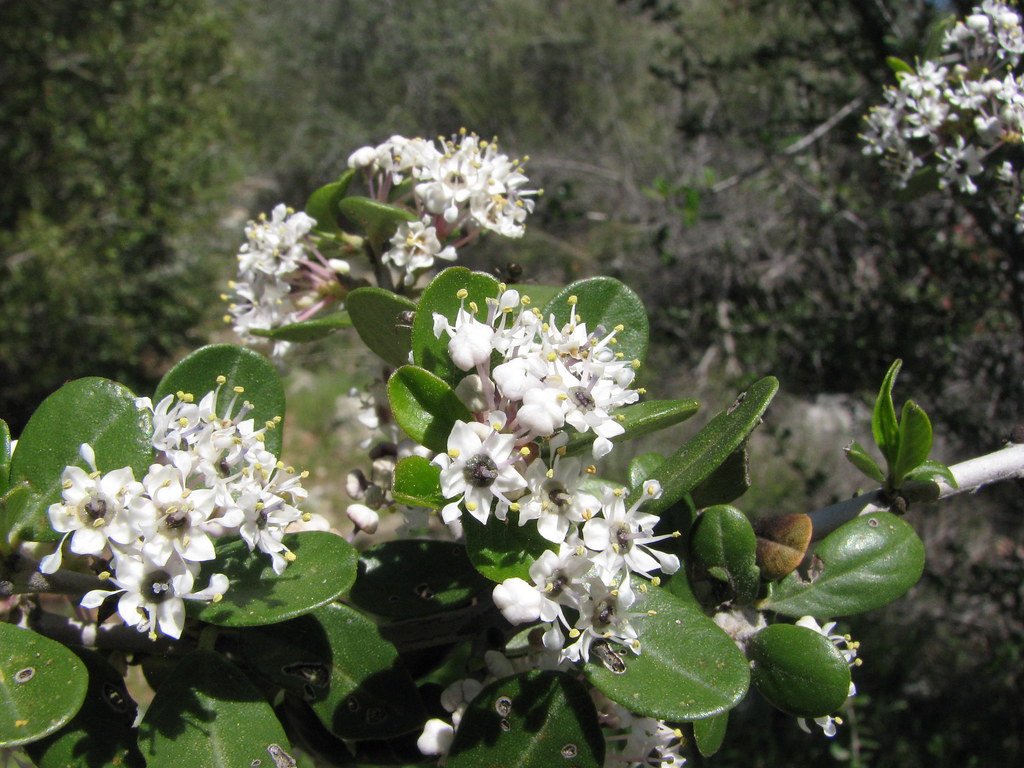
54
Manzanita, Arctostaphylos manzanita “Dr. Hurd.” Evergreen shrub, 10’ to 15’ tall, 8’ to 10’ wide, full sun to part shade, low moisture. Multi-branched treelike shrub with reddish bark. Glossy light green foliage. Small white flowers, berries. Berries and leaves used for tea. Extract for headaches. Lotion for relief from poison oak.
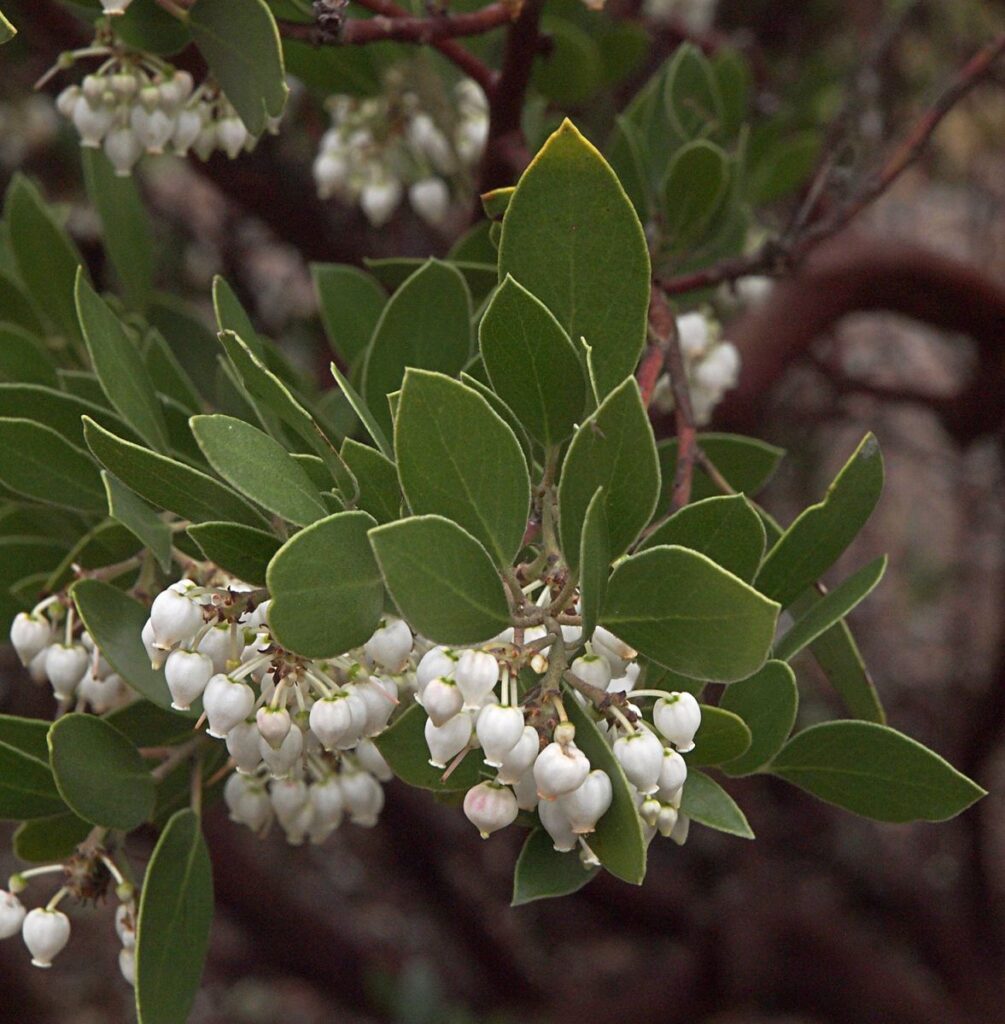
55
Vine Maple, Acer circinatum. Maple tree or shrub native to California. 15’ to 30’ tall, 3’to 6’ wide, shade and part shade, usually grows in understory of forest, low moisture. Brilliantly colored leaves in fall. Supports birds. Tiny purple and white flowers in spring. Long straight stems for baskets. Wood carved into spoons, bowls. Branches used as scoop nets for catching salmon.
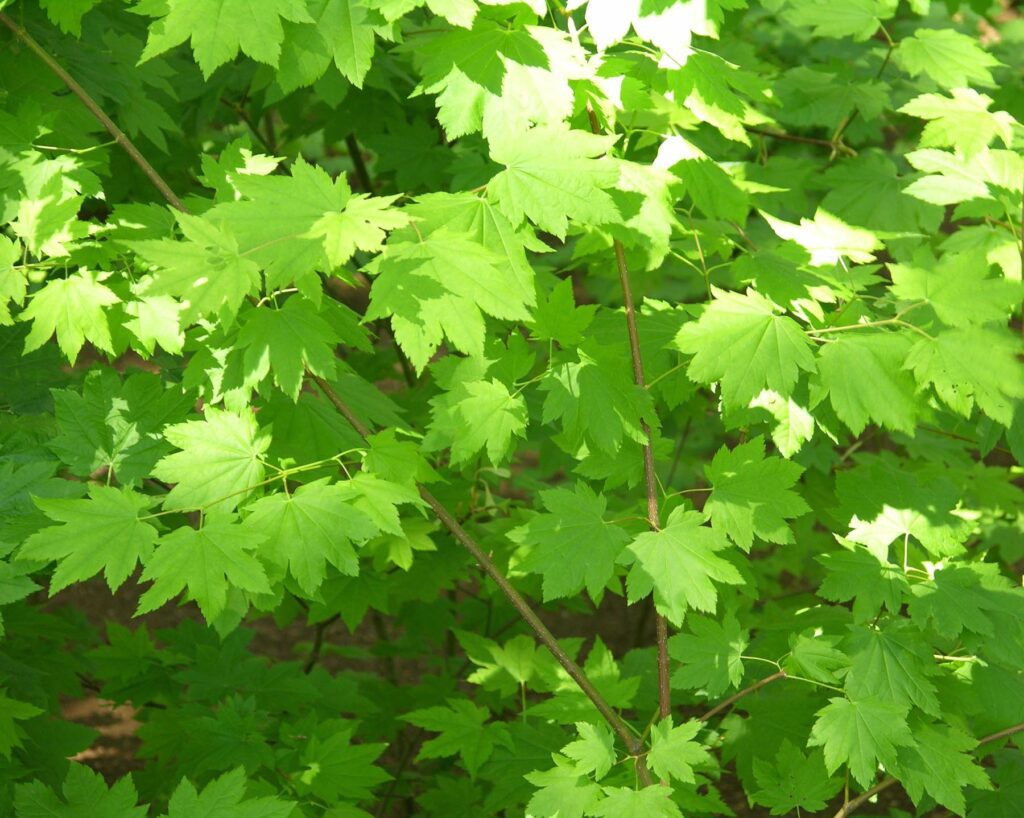
56
Island Snapdragon, Galvezia speciose. Vine-like dense evergreen shrub, sprawling, 1’ to 3’ tall, 10’ wide. Full sun to part shade, very low moisture. Supports hummingbirds and insects. Small lime green leaves. Trumpet shaped lipstick red flowers, can bloom almost year round. No native American uses found.
